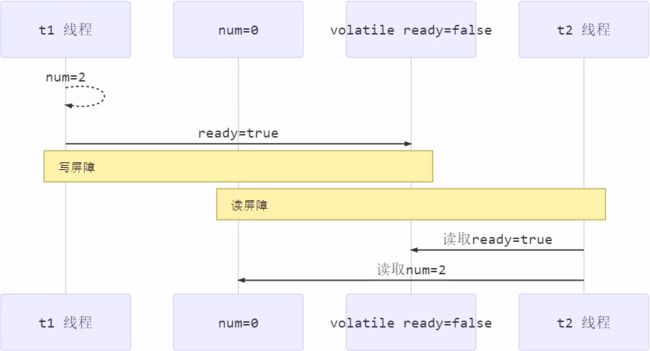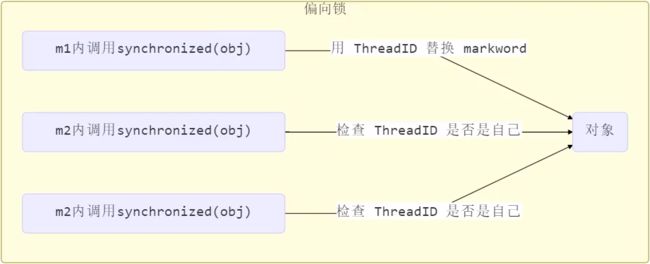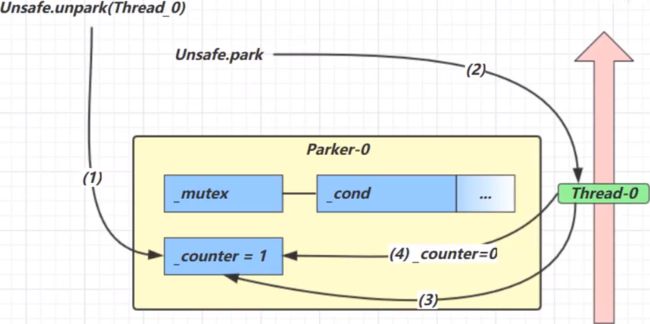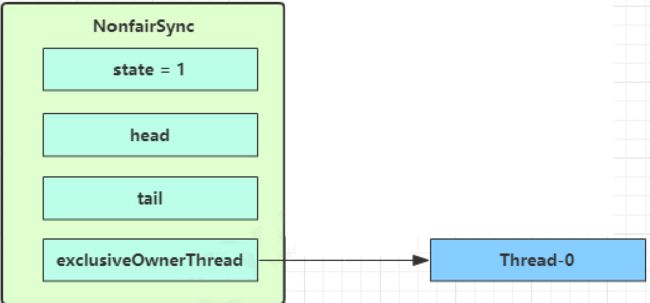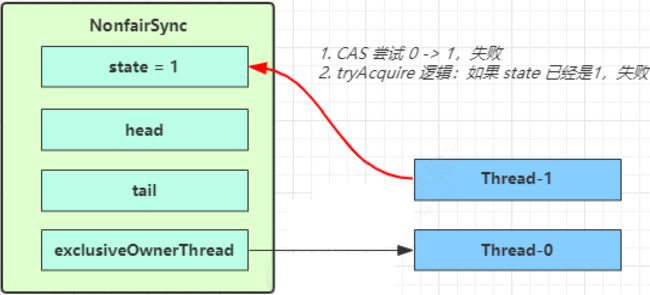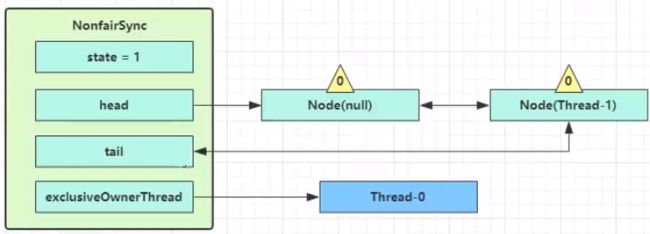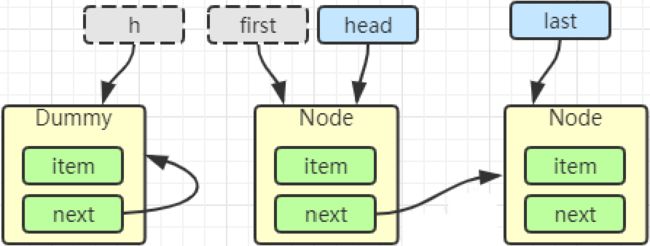JUC-并发编程-原理
并发编程原理
- 指令级并行原理
- 1. 名词
- Clock Cycle Time
- CPI
- IPC
- CPU 执行时间
- 2. 鱼罐头的故事
- 3. 指令重排序优化
- 4. 支持流水线的处理器
- 5. SuperScalar 处理器
- CPU 缓存结构原理
- 1. CPU 缓存结构
- 2. CPU 缓存读
- 3. CPU 缓存一致性
- 4. 内存屏障
- volatile 原理
- 1. 如何保证可见性
- 2. 如何保证有序性
- 3. double-checked locking 问题
- 4. double-checked locking 解决
- final 原理
- 1. 设置 final 变量的原理
- 2. 获取 final 变量的原理
- Monitor 原理
- synchronized 原理
- synchronized 原理进阶
- 1. 轻量级锁
- 2. 锁膨胀
- 3. 自旋优化
- 4. 偏向锁
- 偏向状态
- 撤销 - 调用对象 hashCode
- 撤销 - 其它线程使用对象
- 撤销 - 调用 wait/notify
- 批量重偏向
- 批量撤销
- 5. 锁消除
- wait notify 原理
- join 原理
- park unpark 原理
- AQS 原理
- 1. 概述
- 2. 实现不可重入锁
- 自定义同步器
- 自定义锁
- 3. 心得
- 起源
- 目标
- 设计
- 1) state 设计
- 2) 阻塞恢复设计
- 3) 队列设计
- 主要用到 AQS 的并发工具类
- ReentrantLock 原理
- 1. 非公平锁实现原理
- 加锁解锁流程
- 加锁源码
- 解锁源码
- 2. 可重入原理
- 3. 可打断原理
- 不可打断模式
- 可打断模式
- 4. 公平锁实现原理
- 5. 条件变量实现原理
- await 流程
- signal 流程
- 源码
- 读写锁原理
- 1. 图解流程
- t1 w.lock,t2 r.lock
- t3 r.lock,t4 w.lock
- t1 w.unlock
- t2 r.unlock,t3 r.unlock
- 2. 源码分析
- 写锁上锁流程
- 写锁释放流程
- 读锁上锁流程
- 读锁释放流程
- Semaphore 原理
- 1. 加锁解锁流程
- 2. 源码分析
- 3. 为什么要有 PROPAGATE
- 正常流程
- 产生 bug 的情况
- bug 修复后
- ConcurrentHashMap 原理
- 1. JDK 7 HashMap 并发死链
- 测试代码
- 死链复现
- 源码分析
- 小结
- 2. JDK 8 ConcurrentHashMap
- 重要属性和内部类
- 重要方法
- 构造器分析
- get 流程
- put 流程
- size 计算流程
- 3. JDK 7 ConcurrentHashMap
- 构造器分析
- put 流程
- rehash 流程
- get 流程
- size 计算流程
- LinkedBlockingQueue 原理
- 1. 基本的入队出队
- 2. 加锁分析
- 3. 性能比较
- ConcurrentLinkedQueue 原理
- 1. 模仿 ConcurrentLinkedQueue
指令级并行原理
1. 名词
Clock Cycle Time
主频的概念大家接触的比较多,而 CPU 的 Clock Cycle Time(时钟周期时间),等于主频的倒数,意思是 CPU 能够识别的最小时间单位,比如说 4G 主频的 CPU 的 Clock Cycle Time 就是 0.25 ns,作为对比,我们墙上挂钟的 Cycle Time 是 1s
例如,运行一条加法指令一般需要一个时钟周期时间
CPI
有的指令需要更多的时钟周期时间,所以引出了 CPI (Cycles Per Instruction)指令平均时钟周期数
IPC
IPC(Instruction Per Clock Cycle) 即 CPI 的倒数,表示每个时钟周期能够运行的指令数
CPU 执行时间
程序的 CPU 执行时间,即我们前面提到的 user + system 时间,可以用下面的公式来表示
程序 CPU 执行时间 = 指令数 * CPI * Clock Cycle Time
2. 鱼罐头的故事
加工一条鱼需要 50 分钟,只能一条鱼、一条鱼顺序加工…

可以将每个鱼罐头的加工流程细分为 5 个步骤:
- 去鳞清洗 10分钟
- 蒸煮沥水 10分钟
- 加注汤料 10分钟
- 杀菌出锅 10分钟
- 真空封罐 10分钟

即使只有一个工人,最理想的情况是:他能够在 10 分钟内同时做好这 5 件事,因为对第一条鱼的真空装罐,不会影响对第二条鱼的杀菌出锅…
3. 指令重排序优化
事实上,现代处理器会设计为一个时钟周期完成一条执行时间最长的 CPU 指令。为什么这么做呢?可以想到指令还可以再划分成一个个更小的阶段,例如,每条指令都可以分为: 取指令 - 指令译码 - 执行指令 - 内存访问 - 数据写回 这 5 个阶段

术语参考:
- instruction fetch (IF)
- instruction decode (ID)
- execute (EX)
- memory access (MEM)
- register write back (WB)
在不改变程序结果的前提下,这些指令的各个阶段可以通过重排序和组合来实现指令级并行,这一技术在 80’s 中叶到 90’s 中叶占据了计算架构的重要地位。
提示:
?分阶段,分工是提升效率的关键!
指令重排的前提是,重排指令不能影响结果,例如
// 可以重排的例子
int a = 10; // 指令1
int b = 20; // 指令2
System.out.println( a + b );
// 不能重排的例子
int a = 10; // 指令1
int b = a - 5; // 指令2
参考: Scoreboarding and the Tomasulo algorithm (which is similar to scoreboarding but makes use ofregister renaming) are two of the most common techniques for implementing out-of-order execution and instruction-level parallelism.
4. 支持流水线的处理器
现代 CPU 支持多级指令流水线,例如支持同时执行 取指令 - 指令译码 - 执行指令 - 内存访问 - 数据写回 的处理器,就可以称之为五级指令流水线。这时 CPU 可以在一个时钟周期内,同时运行五条指令的不同阶段(相当于一条执行时间最长的复杂指令),IPC = 1,本质上,流水线技术并不能缩短单条指令的执行时间,但它变相地提高了指令地吞吐率。
提示:
奔腾四(Pentium 4)支持高达 35 级流水线,但由于功耗太高被废弃
5. SuperScalar 处理器
大多数处理器包含多个执行单元,并不是所有计算功能都集中在一起,可以再细分为整数运算单元、浮点数运算单元等,这样可以把多条指令也可以做到并行获取、译码等,CPU 可以在一个时钟周期内,执行多于一条指令,IPC > 1
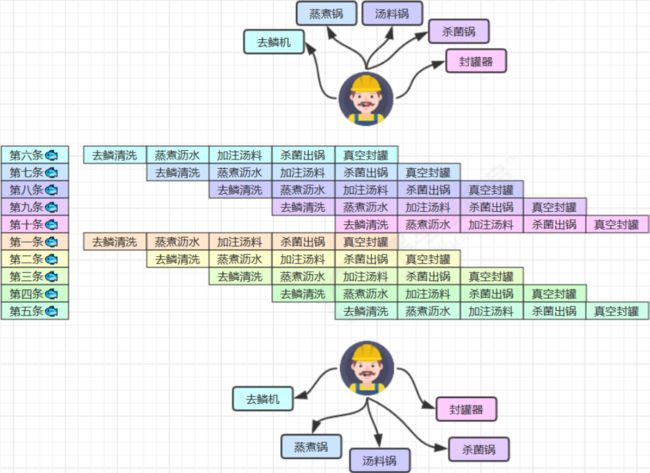
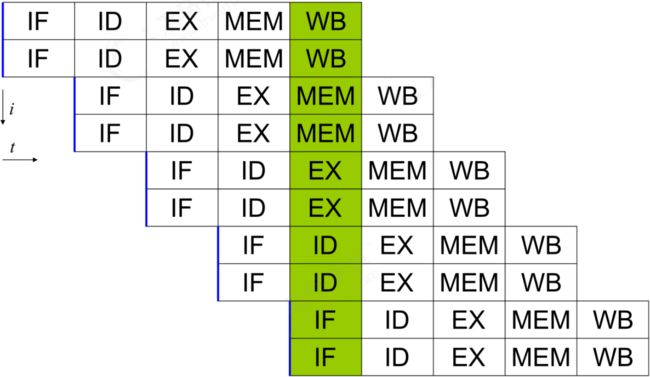
CPU 缓存结构原理
1. CPU 缓存结构
查看 cpu 缓存
⚡ root@yihang01 ~ lscpu
Architecture: x86_64
CPU op-mode(s): 32-bit, 64-bit
Byte Order: Little Endian
CPU(s): 1
On-line CPU(s) list: 0
Thread(s) per core: 1
Core(s) per socket: 1
Socket(s): 1
NUMA node(s): 1
Vendor ID: GenuineIntel
CPU family: 6
Model: 142
Model name: Intel(R) Core(TM) i7-8565U CPU @ 1.80GHz
Stepping: 11
CPU MHz: 1992.002
BogoMIPS: 3984.00
Hypervisor vendor: VMware
Virtualization type: full
L1d cache: 32K
L1i cache: 32K
L2 cache: 256K
L3 cache: 8192K
NUMA node0 CPU(s): 0
速度比较
| 从 cpu 到 | 大约需要的时钟周期 |
|---|---|
| 寄存器 | 1 cycle |
| L1 | 3~4 cycle |
| L2 | 10~20 cycle |
| L3 | 40~45 cycle |
| 内存 | 120~240 cycle |
查看 cpu 缓存行
⚡ root@yihang01 ~ cat /sys/devices/system/cpu/cpu0/cache/index0/coherency_line_size
64
cpu 拿到的内存地址格式是这样的
[高位组标记][低位索引][偏移量]
2. CPU 缓存读
读取数据流程如下
- 根据低位,计算在缓存中的索引
- 判断是否有效
- 0 去内存读取新数据更新缓存行
- 1 再对比高位组标记是否一致
- 一致,根据偏移量返回缓存数据
- 不一致,去内存读取新数据更新缓存行
3. CPU 缓存一致性
MESI 协议
-
E、S、M 状态的缓存行都可以满足 CPU 的读请求
-
E 状态的缓存行,有写请求,会将状态改为 M,这时并不触发向主存的写
-
E 状态的缓存行,必须监听该缓存行的读操作,如果有,要变为 S 状态
-
M 状态的缓存行,必须监听该缓存行的读操作,如果有,先将其它缓存(S 状态)中该缓存行变成 I 状态(即
-
的流程),写入主存,自己变为 S 状态
-
S 状态的缓存行,有写请求,走 4. 的流程
-
S 状态的缓存行,必须监听该缓存行的失效操作,如果有,自己变为 I 状态
-
I 状态的缓存行,有读请求,必须从主存读取
4. 内存屏障
Memory Barrier(Memory Fence)
- 可见性
- 写屏障(sfence)保证在该屏障之前的,对共享变量的改动,都同步到主存当中
- 而读屏障(lfence)保证在该屏障之后,对共享变量的读取,加载的是主存中最新数据
- 有序性
- 写屏障会确保指令重排序时,不会将写屏障之前的代码排在写屏障之后
- 读屏障会确保指令重排序时,不会将读屏障之后的代码排在读屏障之前
volatile 原理
volatile 的底层实现原理是内存屏障,Memory Barrier(Memory Fence)
- 对 volatile 变量的写指令后会加入写屏障
- 对 volatile 变量的读指令前会加入读屏障
1. 如何保证可见性
- 写屏障(sfence)保证在该屏障之前的,对共享变量的改动,都同步到主存当中
public void actor2(I_Result r) {
num = 2;// volatile 之前的变量改动也会被同步
ready = true; // ready 是 volatile 赋值带写屏障
// 写屏障
}
- 而读屏障(lfence)保证在该屏障之后,对共享变量的读取,加载的是主存中最新数据
public void actor1(I_Result r) {
// 读屏障
// ready 是 volatile 读取值带读屏障
if(ready) {
r.r1 = num + num;
} else {
r.r1 = 1;
}
}
2. 如何保证有序性
- 写屏障会确保指令重排序时,不会将写屏障之前的代码排在写屏障之后
public void actor2(I_Result r) {
num = 2;
ready = true; // ready 是 volatile 赋值带写屏障
// 写屏障
}
- 读屏障会确保指令重排序时,不会将读屏障之后的代码排在读屏障之前
public void actor1(I_Result r) {
// 读屏障
// ready 是 volatile 读取值带读屏障
if(ready) {
r.r1 = num + num;
} else {
r.r1 = 1;
}
}
还是那句话,不能解决指令交错:
- 写屏障仅仅是保证之后的读能够读到最新的结果,但不能保证读跑到它前面去
- 而有序性的保证也只是保证了本线程内相关代码不被重排序
3. double-checked locking 问题
以著名的 double-checked locking 单例模式为例
public final class Singleton {
private Singleton() { }
private static Singleton INSTANCE = null;
public static Singleton getInstance() {
if(INSTANCE == null) { // t2
// 首次访问会同步,而之后的使用没有 synchronized
synchronized(Singleton.class) {
if (INSTANCE == null) { // t1
INSTANCE = new Singleton();
}
}
}
return INSTANCE;
}
}
以上的实现特点是:
- 懒惰实例化
- 首次使用 getInstance() 才使用 synchronized 加锁,后续使用时无需加锁
- 有隐含的,但很关键的一点:第一个 if 使用了 INSTANCE 变量,是在同步块之外
但在多线程环境下,上面的代码是有问题的,getInstance 方法对应的字节码为:
0: getstatic #2 // Field INSTANCE:Lcn/itcast/n5/Singleton;
3: ifnonnull 37
6: ldc #3 // class cn/itcast/n5/Singleton
8: dup
9: astore_0
10: monitorenter
11: getstatic #2 // Field INSTANCE:Lcn/itcast/n5/Singleton;
14: ifnonnull 27
17: new #3 // class cn/itcast/n5/Singleton
20: dup
21: invokespecial #4 // Method "":()V
24: putstatic #2 // Field INSTANCE:Lcn/itcast/n5/Singleton;
27: aload_0
28: monitorexit
29: goto 37
32: astore_1
33: aload_0
34: monitorexit
35: aload_1
36: athrow
37: getstatic #2 // Field INSTANCE:Lcn/itcast/n5/Singleton;
40: areturn
其中
- 17 表示创建对象,将对象引用入栈 // new Singleton
- 20 表示复制一份对象引用 // 引用地址
- 21 表示利用一个对象引用,调用构造方法
- 24 表示利用一个对象引用,赋值给 static INSTANCE
也许 jvm 会优化为:先执行 24,再执行 21。如果两个线程 t1,t2 按如下时间序列执行:
关键在于 0: getstatic 这行代码在 monitor 控制之外,它就像之前举例中不守规则的人,可以越过 monitor 读取 INSTANCE 变量的值
这时 t1 还未完全将构造方法执行完毕,如果在构造方法中要执行很多初始化操作,那么 t2 拿到的是将是一个未初始化完毕的单例
对 INSTANCE 使用 volatile 修饰即可,可以禁用指令重排,但要注意在 JDK 5 以上的版本的 volatile 才会真正有效
4. double-checked locking 解决
public final class Singleton {
private Singleton() { }
private static volatile Singleton INSTANCE = null;
public static Singleton getInstance() {
// 实例没创建,才会进入内部的 synchronized代码块
if (INSTANCE == null) {
synchronized (Singleton.class) { // t2
// 也许有其它线程已经创建实例,所以再判断一次
if (INSTANCE == null) { // t1
INSTANCE = new Singleton();
}
}
}
return INSTANCE;
}
}
字节码上看不出来 volatile 指令的效果
// -------------------------------------> 加入对 INSTANCE 变量的读屏障
0: getstatic #2 // Field INSTANCE:Lcn/itcast/n5/Singleton;
3: ifnonnull 37
6: ldc #3 // class cn/itcast/n5/Singleton
8: dup
9: astore_0
10: monitorenter -----------------------> 保证原子性、可见性
11: getstatic #2 // Field INSTANCE:Lcn/itcast/n5/Singleton;
14: ifnonnull 27
17: new #3 // class cn/itcast/n5/Singleton
20: dup
21: invokespecial #4 // Method "":()V
24: putstatic #2 // Field INSTANCE:Lcn/itcast/n5/Singleton;
// -------------------------------------> 加入对 INSTANCE 变量的写屏障
27: aload_0
28: monitorexit ------------------------> 保证原子性、可见性
29: goto 37
32: astore_1
33: aload_0
34: monitorexit
35: aload_1
36: athrow
37: getstatic #2 // Field INSTANCE:Lcn/itcast/n5/Singleton;
40: areturn
如上面的注释内容所示,读写 volatile 变量时会加入内存屏障(Memory Barrier(Memory Fence)),保证下面两点:
- 可见性
- 写屏障(sfence)保证在该屏障之前的 t1 对共享变量的改动,都同步到主存当中
- 而读屏障(lfence)保证在该屏障之后 t2 对共享变量的读取,加载的是主存中最新数据
- 有序性
- 写屏障会确保指令重排序时,不会将写屏障之前的代码排在写屏障之后
- 读屏障会确保指令重排序时,不会将读屏障之后的代码排在读屏障之前
- 更底层是读写变量时使用 lock 指令来多核 CPU 之间的可见性与有序性
final 原理
1. 设置 final 变量的原理
理解了 volatile 原理,再对比 final 的实现就比较简单了
public class TestFinal {
final int a = 20;
}
0: aload_0
1: invokespecial #1 // Method java/lang/Object."":()V
4: aload_0
5: bipush 20
7: putfield #2 // Field a:I
<-- 写屏障
10: return
发现 final 变量的赋值也会通过 putfield 指令来完成,同样在这条指令之后也会加入写屏障,保证在其它线程读到它的值时不会出现为 0 的情况
2. 获取 final 变量的原理
final static int A = 10;//数字较小
final static int B = Short.MAX_VALUE + 1;//数字较大
较小的数字会将数值复制一份放到方法栈中,较大会将数值放入常量池中,如果不加 final 则会直接放入堆中。
Monitor 原理
Monitor 被翻译为监视器或管程
每个 Java 对象都可以关联一个 Monitor 对象(操作系统提供的对象),如果使用 synchronized 给对象上锁(重量级)之后,该对象头的 Mark Word 中就被设置指向 Monitor 对象的指针
- 刚开始 Monitor 中 Owner 为 null
- 当 Thread-2 执行 synchronized(obj) 就会将 Monitor 的所有者 Owner 置为 Thread-2,Monitor中只能有一个 Owner
- 在 Thread-2 上锁的过程中,如果 Thread-3,Thread-4,Thread-5 也来执行 synchronized(obj),就会进入EntryList BLOCKED
- Thread-2 执行完同步代码块的内容,然后唤醒 EntryList 中等待的线程来竞争锁,竞争的时是非公平的
- 图中 WaitSet 中的 Thread-0,Thread-1 是之前获得过锁,但条件不满足进入 WAITING 状态的线程(wait-notify)。
注意:
- synchronized 必须是进入同一个对象的 monitor 才有上述的效果,不同的对象关联着不同的 monitor
- 不加 synchronized 的对象不会关联监视器,不遵从以上规则
synchronized 原理
static final Object lock = new Object();
static int counter = 0;
public static void main(String[] args) {
synchronized (lock) {
counter++;
}
}
对应的字节码为
public static void main(java.lang.String[]);
descriptor: ([Ljava/lang/String;)V
flags: ACC_PUBLIC, ACC_STATIC
Code:
stack=2, locals=3, args_size=1
0: getstatic #2 // <- lock引用 (synchronized开始)
3: dup
4: astore_1 // lock引用 -> slot 1
5: monitorenter // 将 lock对象 MarkWord 置为 Monitor 指针
6: getstatic #3 // <- i
9: iconst_1 // 准备常数 1
10: iadd // +1
11: putstatic #3 // -> i
14: aload_1 // <- lock引用
15: monitorexit // 将 lock对象 MarkWord 重置, 唤醒 EntryList
16: goto 24
19: astore_2 // e -> slot 2
20: aload_1 // <- lock引用
21: monitorexit // 将 lock对象 MarkWord 重置, 唤醒 EntryList
22: aload_2 // <- slot 2 (e)
23: athrow // throw e
24: return
Exception table:
from to target type
6 16 19 any
19 22 19 any
LineNumberTable:
line 8: 0
line 9: 6
line 10: 14
line 11: 24
LocalVariableTable:
Start Length Slot Name Signature
0 25 0 args [Ljava/lang/String;
StackMapTable: number_of_entries = 2
frame_type = 255 /* full_frame */
offset_delta = 19
locals = [ class "[Ljava/lang/String;", class java/lang/Object ]
stack = [ class java/lang/Throwable ]
frame_type = 250 /* chop */
offset_delta = 4
注意
方法级别的 synchronized 不会在字节码指令中有所体现
synchronized 原理进阶
1. 轻量级锁
轻量级锁的使用场景:如果一个对象虽然有多线程要加锁,但加锁的时间是错开的(也就是没有竞争),那么可以使用轻量级锁来优化。
轻量级锁对使用者是透明的,即语法仍然是 synchronized
假设有两个方法同步块,利用同一个对象加锁
static final Object obj = new Object();
public static void method1() {
synchronized( obj ) {
// 同步块 A
method2();
}
}
public static void method2() {
synchronized( obj ) {
// 同步块 B
}
}
- 创建锁记录(Lock Record)对象,每个线程都的栈帧都会包含一个锁记录的结构,内部可以存储锁定对象的Mark Word

- 让锁记录中 Object reference 指向锁对象,并尝试用 cas 替换 Object 的 Mark Word,将 Mark Word 的值存入锁记录
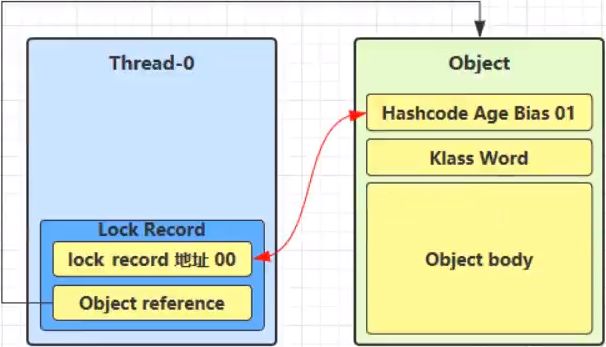
- 如果 cas 替换成功,对象头中存储了 锁记录地址和状态 00(轻量级锁) ,表示由该线程给对象加锁,这时图示如下
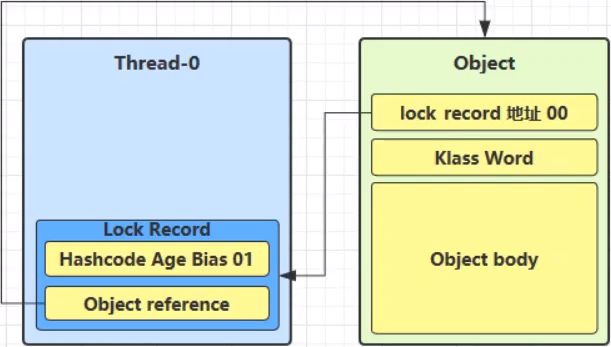
- 如果 cas 失败,有两种情况
- 如果是其它线程已经持有了该 Object 的轻量级锁,这时表明有竞争,进入锁膨胀过程
- 如果是自己执行了 synchronized 锁重入,那么再添加一条 Lock Record 作为重入的计数

- 当退出 synchronized 代码块(解锁时)如果有取值为 null 的锁记录,表示有重入,这时重置锁记录,表示重入计数减一

- 当退出 synchronized 代码块(解锁时)锁记录的值不为 null,这时使用 cas 将 Mark Word 的值恢复给对象头
- 成功,则解锁成功
- 失败,说明轻量级锁进行了锁膨胀或已经升级为重量级锁,进入重量级锁解锁流程
2. 锁膨胀
如果在尝试加轻量级锁的过程中,CAS 操作无法成功,这时一种情况就是有其它线程为此对象加上了轻量级锁(有竞争),这时需要进行锁膨胀,将轻量级锁变为重量级锁。
static Object obj = new Object();
public static void method1() {
synchronized( obj ) {
// 同步块
}
}
- 当 Thread-1 进行轻量级加锁时,Thread-0 已经对该对象加了轻量级锁

- 这时 Thread-1 加轻量级锁失败,进入锁膨胀流程
- 即为 Object 对象申请 Monitor 锁,让 Object 指向重量级锁地址 状态变为 10(重量级锁)
- 然后自己进入 Monitor 的 EntryList BLOCKED
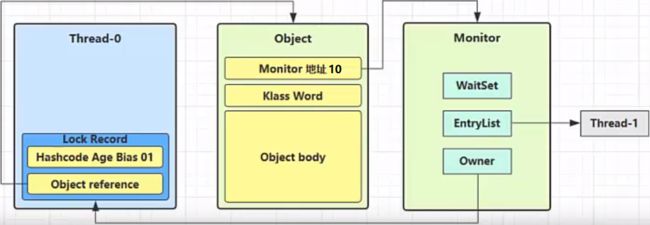
- 当 Thread-0 退出同步块解锁时,使用 cas 将 Mark Word 的值恢复给对象头,失败。这时会进入重量级解锁流程,即按照 Monitor 地址找到 Monitor 对象,设置 Owner 为 null,唤醒 EntryList 中 BLOCKED 线程
3. 自旋优化
重量级锁竞争的时候,还可以使用自旋来进行优化,如果当前线程自旋成功(即这时候持锁线程已经退出了同步块,释放了锁),这时当前线程就可以避免阻塞。
自旋重试成功的情况
| 线程1(cpu 1 上) | 对象Mark Word | 线程2(cpu 2 上) |
|---|---|---|
| - | 10(重量锁) | - |
| 访问同步块,获取 monitor | 10 (重量锁)重量锁指针 | - |
| 成功(加锁) | 10 (重量锁)重量锁指针 | - |
| 执行同步块 | 10 (重量锁)重量锁指针 | - |
| 执行同步块 | 10 (重量锁)重量锁指针 | 访问同步块,获取 monitor |
| 执行同步块 | 10 (重量锁)重量锁指针 | 自旋重试 |
| 执行完毕 | 10 (重量锁)重量锁指针 | 自旋重试 |
| 成功(解锁) | 01(无锁) | 自旋重试 |
| - | 10 (重量锁)重量锁指针 | 成功(加锁) |
| - | 10 (重量锁)重量锁指针 | 执行同步块 |
| - | … | … |
自旋重试失败的情况
| 线程1(cpu 1 上) | 对象Mark Word | 线程2(cpu 2 上) |
|---|---|---|
| - | 10(重量锁) | - |
| 访问同步块,获取 monitor | 10 (重量锁)重量锁指针 | - |
| 成功(加锁) | 10 (重量锁)重量锁指针 | - |
| 执行同步块 | 10 (重量锁)重量锁指针 | - |
| 执行同步块 | 10 (重量锁)重量锁指针 | 访问同步块,获取 monitor |
| 执行同步块 | 10 (重量锁)重量锁指针 | 自旋重试 |
| 执行同步块 | 10 (重量锁)重量锁指针 | 自旋重试 |
| 执行同步块 | 10 (重量锁)重量锁指针 | 自旋重试 |
| 执行同步块 | 10 (重量锁)重量锁指针 | 阻塞 |
| - | … | … |
- 自旋会占用 CPU 时间,单核 CPU 自旋就是浪费,多核 CPU 自旋才能发挥优势。
- 在 Java 6 之后自旋锁是自适应的,比如对象刚刚的一次自旋操作成功过,那么认为这次自旋成功的可能性会高,就多自旋几次;反之,就少自旋甚至不自旋,总之,比较智能。
- Java 7 之后不能控制是否开启自旋功能
4. 偏向锁
轻量级锁在没有竞争时(就自己这个线程),每次重入仍然需要执行 CAS 操作。
Java 6 中引入了偏向锁来做进一步优化:只有第一次使用 CAS 将线程 ID 设置到对象的 Mark Word 头,之后发现这个线程 ID 是自己的就表示没有竞争,不用重新 CAS。以后只要不发生竞争,这个对象就归该线程所有
例如:
static final Object obj = new Object();
public static void m1() {
synchronized (obj) {
// 同步块 A
m2();
}
}
public static void m2() {
synchronized (obj) {
// 同步块 B
m3();
}
}
public static void m3() {
synchronized (obj) {
// 同步块 C
}
}
偏向状态
一个对象创建时:
- 如果开启了偏向锁(默认开启),那么对象创建后,markword 值为 0x05 即最后 3 位为 101,这时它的 thread、epoch、age 都为 0
- 偏向锁是默认是延迟的,不会在程序启动时立即生效,如果想避免延迟,可以加 VM 参数 -XX:BiasedLockingStartupDelay=0 来禁用延迟
- 如果没有开启偏向锁,那么对象创建后,markword 值为 0x01 即最后 3 位为 001,这时它的 hashcode、age 都为 0,第一次用到 hashcode 时才会赋值
1) 测试延迟特性
2) 测试偏向锁
class Dog {}
利用 jol 第三方工具来查看对象头信息(注意这里我扩展了 jol 让它输出更为简洁)
<dependency>
<groupId>org.openjdk.jol</groupId>
<artifactId>jol-core</artifactId>
<version>0.10</version>
</dependency>
// 添加虚拟机参数 -XX:BiasedLockingStartupDelay=0
public static void main(String[] args) throws IOException {
Dog d = new Dog();
ClassLayout classLayout = ClassLayout.parseInstance(d);
new Thread(() -> {
log.debug("synchronized 前");
System.out.println(classLayout.toPrintableSimple(true));
synchronized (d) {
log.debug("synchronized 中");
System.out.println(classLayout.toPrintableSimple(true));
}
log.debug("synchronized 后");
System.out.println(classLayout.toPrintableSimple(true));
}, "t1").start();
}
输出
11:08:58.117 c.TestBiased [t1] - synchronized 加锁前
00000000 00000000 00000000 00000000 00000000 00000000 00000000 00000101
11:08:58.121 c.TestBiased [t1] - synchronized 中
00000000 00000000 00000000 00000000 00011111 11101011 11010000 00000101
11:08:58.121 c.TestBiased [t1] - synchronized 解锁后
00000000 00000000 00000000 00000000 00011111 11101011 11010000 00000101
注意
处于偏向锁的对象解锁后,线程 id 仍存储于对象头中
3)测试禁用
在上面测试代码运行时在添加 VM 参数 -XX:-UseBiasedLocking 禁用偏向锁
输出
11:13:10.018 c.TestBiased [t1] - synchronized 加锁前
00000000 00000000 00000000 00000000 00000000 00000000 00000000 00000001
11:13:10.021 c.TestBiased [t1] - synchronized 中
00000000 00000000 00000000 00000000 00100000 00010100 11110011 10001000
11:13:10.021 c.TestBiased [t1] - synchronized 解锁后
00000000 00000000 00000000 00000000 00000000 00000000 00000000 00000001
- 测试 hashCode
正常状态对象一开始是没有 hashCode 的,第一次调用才生成
撤销 - 调用对象 hashCode
调用了对象的 hashCode,但偏向锁的对象 MarkWord 中存储的是线程 id,如果调用 hashCode 会导致偏向锁被撤销
- 轻量级锁会在锁记录中记录 hashCode
- 重量级锁会在 Monitor 中记录 hashCode
在调用 hashCode 后使用偏向锁,记得去掉 -XX:-UseBiasedLocking
输出
11:22:10.386 c.TestBiased [main] - 调用 hashCode:1778535015
11:22:10.391 c.TestBiased [t1] - synchronized 前
00000000 00000000 00000000 01101010 00000010 01001010 01100111 00000001
11:22:10.393 c.TestBiased [t1] - synchronized 中
00000000 00000000 00000000 00000000 00100000 11000011 11110011 01101000
11:22:10.393 c.TestBiased [t1] - synchronized 后
00000000 00000000 00000000 01101010 00000010 01001010 01100111 00000001
撤销 - 其它线程使用对象
当有其它线程使用偏向锁对象时,会将偏向锁升级为轻量级锁
private static void test2() throws InterruptedException {
Dog d = new Dog();
Thread t1 = new Thread(() -> {
synchronized (d) {
log.debug(ClassLayout.parseInstance(d).toPrintableSimple(true));
}
synchronized (TestBiased.class) {
TestBiased.class.notify();
}
// 如果不用 wait/notify 使用 join 必须打开下面的注释
// 因为:t1 线程不能结束,否则底层线程可能被 jvm 重用作为 t2 线程,底层线程 id 是一样的
/*try {
System.in.read();
} catch (IOException e) {
e.printStackTrace();
}*/
}, "t1");
t1.start();
Thread t2 = new Thread(() -> {
synchronized (TestBiased.class) {
try {
TestBiased.class.wait();
} catch (InterruptedException e) {
e.printStackTrace();
}
}
log.debug(ClassLayout.parseInstance(d).toPrintableSimple(true));
synchronized (d) {
log.debug(ClassLayout.parseInstance(d).toPrintableSimple(true));
}
log.debug(ClassLayout.parseInstance(d).toPrintableSimple(true));
}, "t2");
t2.start();
}
输出
[t1] - 00000000 00000000 00000000 00000000 00011111 01000001 00010000 00000101
[t2] - 00000000 00000000 00000000 00000000 00011111 01000001 00010000 00000101
[t2] - 00000000 00000000 00000000 00000000 00011111 10110101 11110000 01000000//变为了轻量锁
[t2] - 00000000 00000000 00000000 00000000 00000000 00000000 00000000 00000001
撤销 - 调用 wait/notify
只有重量级锁才有 wait/notify,所以会撤销
public static void main(String[] args) throws InterruptedException {
Dog d = new Dog();
Thread t1 = new Thread(() -> {
log.debug(ClassLayout.parseInstance(d).toPrintableSimple(true));
synchronized (d) {
log.debug(ClassLayout.parseInstance(d).toPrintableSimple(true));
try {
d.wait();
} catch (InterruptedException e) {
e.printStackTrace();
}
log.debug(ClassLayout.parseInstance(d).toPrintableSimple(true));
}
}, "t1");
t1.start();
new Thread(() -> {
try {
Thread.sleep(6000);
} catch (InterruptedException e) {
e.printStackTrace();
}
synchronized (d) {
log.debug("notify");
d.notify();
}
}, "t2").start();
}
输出
[t1] - 00000000 00000000 00000000 00000000 00000000 00000000 00000000 00000101
[t1] - 00000000 00000000 00000000 00000000 00011111 10110011 11111000 00000101
[t2] - notify
[t1] - 00000000 00000000 00000000 00000000 00011100 11010100 00001101 11001010
批量重偏向
如果对象虽然被多个线程访问,但没有竞争,这时偏向了线程 T1 的对象仍有机会重新偏向 T2,重偏向会重置对象的 Thread ID
当撤销偏向锁阈值超过 20 次后,jvm 会这样觉得,我是不是偏向错了呢,于是会在给这些对象加锁时重新偏向至加锁线程
private static void test3() throws InterruptedException {
Vector<Dog> list = new Vector<>();
Thread t1 = new Thread(() -> {
for (int i = 0; i < 30; i++) {
Dog d = new Dog();
list.add(d);
synchronized (d) {
log.debug(i + "\t" + ClassLayout.parseInstance(d).toPrintableSimple(true));
}
}
synchronized (list) {
list.notify();
}
}, "t1");
t1.start();
Thread t2 = new Thread(() -> {
synchronized (list) {
try {
list.wait();
} catch (InterruptedException e) {
e.printStackTrace();
}
}
log.debug("===============> ");
for (int i = 0; i < 30; i++) {
Dog d = list.get(i);
log.debug(i + "\t" + ClassLayout.parseInstance(d).toPrintableSimple(true));
synchronized (d) {
log.debug(i + "\t" + ClassLayout.parseInstance(d).toPrintableSimple(true));
}
log.debug(i + "\t" + ClassLayout.parseInstance(d).toPrintableSimple(true));
}
}, "t2");
t2.start();
}
输出
省略
批量撤销
当撤销偏向锁阈值超过 40 次后,jvm 会这样觉得,自己确实偏向错了,根本就不该偏向。于是整个类的所有对象都会变为不可偏向的,新建的对象也是不可偏向的
static Thread t1,t2,t3;
private static void test4() throws InterruptedException {
Vector<Dog> list = new Vector<>();
int loopNumber = 39;
t1 = new Thread(() -> {
for (int i = 0; i < loopNumber; i++) {
Dog d = new Dog();
list.add(d);
synchronized (d) {
log.debug(i + "\t" + ClassLayout.parseInstance(d).toPrintableSimple(true));
}
}
LockSupport.unpark(t2);
}, "t1");
t1.start();
t2 = new Thread(() -> {
LockSupport.park();
log.debug("===============> ");
for (int i = 0; i < loopNumber; i++) {
Dog d = list.get(i);
log.debug(i + "\t" + ClassLayout.parseInstance(d).toPrintableSimple(true));
synchronized (d) {
log.debug(i + "\t" + ClassLayout.parseInstance(d).toPrintableSimple(true));
}
log.debug(i + "\t" + ClassLayout.parseInstance(d).toPrintableSimple(true));
}
LockSupport.unpark(t3);
}, "t2");
t2.start();
t3 = new Thread(() -> {
LockSupport.park();
log.debug("===============> ");
for (int i = 0; i < loopNumber; i++) {
Dog d = list.get(i);
log.debug(i + "\t" + ClassLayout.parseInstance(d).toPrintableSimple(true));
synchronized (d) {
log.debug(i + "\t" + ClassLayout.parseInstance(d).toPrintableSimple(true));
}
log.debug(i + "\t" + ClassLayout.parseInstance(d).toPrintableSimple(true));
}
}, "t3");
t3.start();
t3.join();
log.debug(ClassLayout.parseInstance(new Dog()).toPrintableSimple(true));
}
参考资料
https://github.com/farmerjohngit/myblog/issues/12
https://www.cnblogs.com/LemonFive/p/11246086.html
https://www.cnblogs.com/LemonFive/p/11248248.html
https://www.oracle.com/technetwork/java/biasedlocking-oopsla2006-wp-149958.pdf
5. 锁消除
锁消除
@Fork(1)
@BenchmarkMode(Mode.AverageTime)
@Warmup(iterations = 3)
@Measurement(iterations = 5)
@OutputTimeUnit(TimeUnit.NANOSECONDS)
public class MyBenchmark {
static int x = 0;
@Benchmark
public void a() throws Exception {
x++;
}
@Benchmark
public void b() throws Exception {
Object o = new Object();
synchronized (o) {
x++;
}
}
}
java -jar benchmarks.jar
Benchmark Mode Samples Score Score error Units
c.i.MyBenchmark.a avgt 5 1.542 0.056 ns/op
c.i.MyBenchmark.b avgt 5 1.518 0.091 ns/op
java -XX:-EliminateLocks -jar benchmarks.jar
Benchmark Mode Samples Score Score error Units
c.i.MyBenchmark.a avgt 5 1.507 0.108 ns/op
c.i.MyBenchmark.b avgt 5 16.976 1.572 ns/op
锁粗化
对相同对象多次加锁,导致线程发生多次重入,可以使用锁粗化方式来优化,这不同于之前讲的细分锁的粒度。
wait notify 原理
- Owner 线程发现条件不满足,调用 wait 方法,即可进入 WaitSet 变为 WAITING 状态
- BLOCKED 和 WAITING 的线程都处于阻塞状态,不占用 CPU 时间片
- BLOCKED 线程会在 Owner 线程释放锁时唤醒
- WAITING 线程会在 Owner 线程调用 notify 或 notifyAll 时唤醒,但唤醒后并不意味者立刻获得锁,仍需进入EntryList 重新竞争
join 原理
是调用者轮询检查线程 alive 状态
t1.join();
等价于下面的代码:
synchronized (t1) {
// 调用者线程进入 t1 的 waitSet 等待, 直到 t1 运行结束
while (t1.isAlive()) {
t1.wait(0);
}
}
注意
join 体现的是【保护性暂停】模式,请参考
park unpark 原理
每个线程都有自己的一个 Parker 对象,由三部分组成 _counter , _cond 和 _mutex 打个比喻
- 线程就像一个旅人,Parker 就像他随身携带的背包,条件变量就好比背包中的帐篷。_counter 就好比背包中的备用干粮(0 为耗尽,1 为充足)
- 调用 park 就是要看需不需要停下来歇息
- 如果备用干粮耗尽,那么钻进帐篷歇息
- 如果备用干粮充足,那么不需停留,继续前进
- 调用 unpark,就好比令干粮充足
- 如果这时线程还在帐篷,就唤醒让他继续前进
- 如果这时线程还在运行,那么下次他调用 park 时,仅是消耗掉备用干粮,不需停留继续前进
- 因为背包空间有限,多次调用 unpark 仅会补充一份备用干粮
- 当前线程调用 Unsafe.park() 方法
- 检查 _counter ,本情况为 0,这时,获得 _mutex 互斥锁
- 线程进入 _cond 条件变量阻塞
- 设置 _counter = 0
- 调用 Unsafe.unpark(Thread_0) 方法,设置 _counter 为 1
- 唤醒 _cond 条件变量中的 Thread_0
- Thread_0 恢复运行
- 设置 _counter 为 0
- 调用 Unsafe.unpark(Thread_0) 方法,设置 _counter 为 1
- 当前线程调用 Unsafe.park() 方法
- 检查 _counter ,本情况为 1,这时线程无需阻塞,继续运行
- 设置 _counter 为 0
AQS 原理
1. 概述
全称是 AbstractQueuedSynchronizer,是阻塞式锁和相关的同步器工具的框架
特点:
- 用 state 属性来表示资源的状态(分独占模式和共享模式),子类需要定义如何维护这个状态,控制如何获取锁和释放锁
- getState - 获取 state 状态
- setState - 设置 state 状态
- compareAndSetState - cas 机制设置 state 状态
- 独占模式是只有一个线程能够访问资源,而共享模式可以允许多个线程访问资源
- 提供了基于 FIFO 的等待队列,类似于 Monitor 的 EntryList
- 条件变量来实现等待、唤醒机制,支持多个条件变量,类似于 Monitor 的 WaitSet
子类主要实现这样一些方法(默认抛出 UnsupportedOperationException)
- tryAcquire
- tryRelease
- tryAcquireShared
- tryReleaseShared
- isHeldExclusively
获取锁的姿势
// 如果获取锁失败
if (!tryAcquire(arg)) {
// 入队, 可以选择阻塞当前线程 park unpark
}
释放锁的姿势
// 如果释放锁成功
if (tryRelease(arg)) {
// 让阻塞线程恢复运行
}
2. 实现不可重入锁
自定义同步器
// 独占锁 同步器类
class MySync extends AbstractQueuedSynchronizer {
@Override
protected boolean tryAcquire(int arg) {
if (compareAndSetState(0, 1)) {
// 加上了锁,并设置 Owner 为当前线程
setExclusiveOwnerThread(Thread.currentThread());
return true;
}
return false;
}
@Override
protected boolean tryRelease(int arg) {
setExclusiveOwnerThread(null);
setState(0);
return true;
}
@Override //是否持有独占锁
protected boolean isHeldExclusively() {
return getState() == 1;
}
public Condition newCondition() {
return new ConditionObject();
}
}
自定义锁
有了自定义同步器,很容易复用 AQS ,实现一个功能完备的自定义锁
// 自定义锁(不可重入锁)
class MyLock implements Lock {
private MySync sync = new MySync();
@Override // 加锁(不成功会进入等待队列等待)
public void lock() {
sync.acquire(1);
}
@Override // 加锁(可打断)
public void lockInterruptibly() throws InterruptedException {
sync.acquireInterruptibly(1);
}
@Override // 尝试加锁(只尝试一次,不成功返回 false)
public boolean tryLock() {
return sync.tryAcquire(1);
}
@Override // 尝试加锁(带超时时间)
public boolean tryLock(long time, TimeUnit unit) throws InterruptedException {
return sync.tryAcquireNanos(1,unit.toNanos(time));
}
@Override // 解锁
public void unlock() {
sync.release(1);
}
@Override // 创建条件变量
public Condition newCondition() {
return sync.newCondition();
}
}
测试一下
MyLock lock = new MyLock();
new Thread(() -> {
lock.lock();
try {
log.debug("locking...");
sleep(1);
} finally {
log.debug("unlocking...");
lock.unlock();
}
},"t1").start();
new Thread(() -> {
lock.lock();
try {
log.debug("locking...");
} finally {
log.debug("unlocking...");
lock.unlock();
}
},"t2").start();
输出
12:44:53:560 [t1] c.TestAqs - locking...
12:44:54:563 [t1] c.TestAqs - unlocking...
12:44:54:563 [t2] c.TestAqs - locking...
12:44:54:563 [t2] c.TestAqs - unlocking...
不可重入测试
如果改为下面代码,会发现自己也会被挡住(只会打印一次 locking)
lock.lock();
log.debug("locking...");
lock.lock();
log.debug("locking...");
3. 心得
起源
早期程序员会自己通过一种同步器去实现另一种相近的同步器,例如用可重入锁去实现信号量,或反之。这显然不够优雅,于是在 JSR166(java 规范提案)中创建了 AQS,提供了这种通用的同步器机制。
目标
AQS 要实现的功能目标
- 阻塞版本获取锁 acquire 和非阻塞的版本尝试获取锁 tryAcquire
- 获取锁超时机制
- 通过打断取消机制
- 独占机制及共享机制
- 条件不满足时的等待机制
要实现的性能目标
Instead, the primary performance goal here is scalability: to predictably maintain efficiency even, or especially, when synchronizers are contended.
设计
AQS 的基本思想其实很简单
获取锁的逻辑
while(state 状态不允许获取) {
if(队列中还没有此线程) {
入队并阻塞
}
}
当前线程出队
释放锁的逻辑
if(state 状态允许了) {
恢复阻塞的线程(s)
}
要点
- 原子维护 state 状态
- 阻塞及恢复线程
- 维护队列
1) state 设计
- state 使用 volatile 配合 cas 保证其修改时的原子性
- state 使用了 32bit int 来维护同步状态,因为当时使用 long 在很多平台下测试的结果并不理想
2) 阻塞恢复设计
- 早期的控制线程暂停和恢复的 api 有 suspend 和 resume,但它们是不可用的,因为如果先调用的 resume 那么 suspend 将感知不到
- 解决方法是使用 park & unpark 来实现线程的暂停和恢复,具体原理在之前讲过了,先 unpark 再 park 也没问题
- park & unpark 是针对线程的,而不是针对同步器的,因此控制粒度更为精细
- park 线程还可以通过 interrupt 打断
3) 队列设计
- 使用了 FIFO 先入先出队列,并不支持优先级队列
- 设计时借鉴了 CLH 队列,它是一种单向无锁队列
队列中有 head 和 tail 两个指针节点,都用 volatile 修饰配合 cas 使用,每个节点有 state 维护节点状态
入队伪代码,只需要考虑 tail 赋值的原子性
do {
// 原来的 tail
Node prev = tail;
// 用 cas 在原来 tail 的基础上改为 node
} while(tail.compareAndSet(prev, node))
出队伪代码
/ prev 是上一个节点
while((Node prev=node.prev).state != 唤醒状态) {
}
// 设置头节点
head = node;
CLH 好处:
- 无锁,使用自旋
- 快速,无阻塞
AQS 在一些方面改进了 CLH
private Node enq(final Node node) {
for (;;) {
Node t = tail;
// 队列中还没有元素 tail 为 null
if (t == null) {
// 将 head 从 null -> dummy
if (compareAndSetHead(new Node()))
tail = head;
} else {
// 将 node 的 prev 设置为原来的 tail
node.prev = t;
// 将 tail 从原来的 tail 设置为 node
if (compareAndSetTail(t, node)) {
// 原来 tail 的 next 设置为 node
t.next = node;
return t;
}
}
}
}
主要用到 AQS 的并发工具类
ReentrantLock 原理
1. 非公平锁实现原理
加锁解锁流程
先从构造器开始看,默认为非公平锁实现
public ReentrantLock() {
sync = new NonfairSync();
}
NonfairSync 继承自 AQS
final void lock() {
if (compareAndSetState(0, 1))
setExclusiveOwnerThread(Thread.currentThread());
else
acquire(1);
}
public final void acquire(int arg) {
if (!tryAcquire(arg) &&
acquireQueued(addWaiter(Node.EXCLUSIVE), arg))
selfInterrupt();
}
- CAS 尝试将 state 由 0 改为 1,结果失败
- 进入 tryAcquire 逻辑,这时 state 已经是1,结果仍然失败
- 接下来进入 addWaiter 逻辑,构造 Node 队列
- 图中黄色三角表示该 Node 的 waitStatus 状态,其中 0 为默认正常状态
- Node 的创建是懒惰的
- 其中第一个 Node 称为 Dummy(哑元)或哨兵,用来占位,并不关联线程
private Node addWaiter(Node mode) {
Node node = new Node(Thread.currentThread(), mode);
// Try the fast path of enq; backup to full enq on failure
Node pred = tail;
if (pred != null) {
node.prev = pred;
if (compareAndSetTail(pred, node)) {
pred.next = node;
return node;
}
}
enq(node);
return node;
}
当前线程进入 acquireQueued 逻辑
- acquireQueued 会在一个死循环中不断尝试获得锁,失败后进入 park 阻塞
- 如果自己是紧邻着 head(排第二位),那么再次 tryAcquire 尝试获取锁,当然这时 state 仍为 1,失败
- 进入 shouldParkAfterFailedAcquire 逻辑,将前驱 node,即 head 的 waitStatus 改为 -1(表示他有责任唤醒他的后继结点),这次返回 false

- shouldParkAfterFailedAcquire 执行完毕回到 acquireQueued ,再次 tryAcquire 尝试获取锁,当然这时
state 仍为 1,失败 - 当再次进入 shouldParkAfterFailedAcquire 时,这时因为其前驱 node 的 waitStatus 已经是 -1,这次返回
true - 进入 parkAndCheckInterrupt, Thread-1 park(灰色表示)
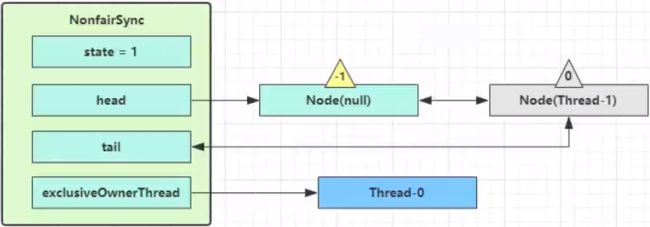
final boolean acquireQueued(final Node node, int arg) {
boolean failed = true;
try {
boolean interrupted = false;
for (;;) {
final Node p = node.predecessor();// 获取前驱结点
if (p == head && tryAcquire(arg)) {
setHead(node);
p.next = null; // help GC
failed = false;
return interrupted;
}
if (shouldParkAfterFailedAcquire(p, node) &&
parkAndCheckInterrupt())
interrupted = true;
}
} finally {
if (failed)
cancelAcquire(node);
}
}
private final boolean parkAndCheckInterrupt() {
LockSupport.park(this);
return Thread.interrupted();
}
再次有多个线程经历上述过程竞争失败,变成这个样子

Thread-0 释放锁,进入 tryRelease 流程,如果成功
- 设置 exclusiveOwnerThread 为 null
- state = 0
public final boolean release(int arg) {
if (tryRelease(arg)) {
Node h = head;
if (h != null && h.waitStatus != 0)
unparkSuccessor(h);// 唤醒后继结点
return true;
}
return false;
}
protected final boolean tryRelease(int releases) {
int c = getState() - releases;
if (Thread.currentThread() != getExclusiveOwnerThread())
throw new IllegalMonitorStateException();
boolean free = false;
if (c == 0) {
free = true;
setExclusiveOwnerThread(null);
}
setState(c);
return free;
}
当前队列不为 null,并且 head 的 waitStatus = -1,进入 unparkSuccessor 流程
找到队列中离 head 最近的一个 Node(没取消的),unpark 恢复其运行,本例中即为 Thread-1
回到 Thread-1 的 acquireQueued 流程

private void unparkSuccessor(Node node) {
int ws = node.waitStatus;
if (ws < 0)
compareAndSetWaitStatus(node, ws, 0);
Node s = node.next;
if (s == null || s.waitStatus > 0) {
s = null;
for (Node t = tail; t != null && t != node; t = t.prev)
if (t.waitStatus <= 0)
s = t;
}
if (s != null)
LockSupport.unpark(s.thread);// 恢复运行
}
如果加锁成功(没有竞争),会设置
- exclusiveOwnerThread 为 Thread-1,state = 1
- head 指向刚刚 Thread-1 所在的 Node,该 Node 清空 Thread
- 原本的 head 因为从链表断开,而可被垃圾回收
如果这时候有其它线程来竞争(非公平的体现),例如这时有 Thread-4 来了

如果不巧又被 Thread-4 占了先
- Thread-4 被设置为 exclusiveOwnerThread,state = 1
- Thread-1 再次进入 acquireQueued 流程,获取锁失败,重新进入 park 阻塞
加锁源码
// Sync 继承自 AQS
static final class NonfairSync extends Sync {
private static final long serialVersionUID = 7316153563782823691L;
// 加锁实现
final void lock() {
// 首先用 cas 尝试(仅尝试一次)将 state 从 0 改为 1, 如果成功表示获得了独占锁
if (compareAndSetState(0, 1))
setExclusiveOwnerThread(Thread.currentThread());
else
// 如果尝试失败,进入 ㈠
acquire(1);
}
// ㈠ AQS 继承过来的方法, 方便阅读, 放在此处
public final void acquire(int arg) {
// ㈡ tryAcquire
if (
!tryAcquire(arg) &&
// 当 tryAcquire 返回为 false 时, 先调用 addWaiter ㈣, 接着 acquireQueued ㈤
acquireQueued(addWaiter(Node.EXCLUSIVE), arg)
) {
selfInterrupt();
}
}
// ㈡ 进入 ㈢
protected final boolean tryAcquire(int acquires) {
return nonfairTryAcquire(acquires);
}
// ㈢ Sync 继承过来的方法, 方便阅读, 放在此处
final boolean nonfairTryAcquire(int acquires) {
final Thread current = Thread.currentThread();
int c = getState();
// 如果还没有获得锁
if (c == 0) {
// 尝试用 cas 获得, 这里体现了非公平性: 不去检查 AQS 队列
if (compareAndSetState(0, acquires)) {
setExclusiveOwnerThread(current);
return true;
}
}
// 如果已经获得了锁, 线程还是当前线程, 表示发生了锁重入
else if (current == getExclusiveOwnerThread()) {
// state++
int nextc = c + acquires;
if (nextc < 0) // overflow
throw new Error("Maximum lock count exceeded");
setState(nextc);
return true;
}
// 获取失败, 回到调用处
return false;
}
// ㈣ AQS 继承过来的方法, 方便阅读, 放在此处
private Node addWaiter(Node mode) {
// 将当前线程关联到一个 Node 对象上, 模式为独占模式
Node node = new Node(Thread.currentThread(), mode);
// 如果 tail 不为 null, cas 尝试将 Node 对象加入 AQS 队列尾部
Node pred = tail;
if (pred != null) {
node.prev = pred;
if (compareAndSetTail(pred, node)) {
// 双向链表
pred.next = node;
return node;
}
}
// 尝试将 Node 加入 AQS, 进入 ㈥
enq(node);
return node;
}
// ㈥ AQS 继承过来的方法, 方便阅读, 放在此处
private Node enq(final Node node) {
for (;;) {
Node t = tail;
if (t == null) {
// 还没有, 设置 head 为哨兵节点(不对应线程,状态为 0)
if (compareAndSetHead(new Node())) {
tail = head;
}
} else {
// cas 尝试将 Node 对象加入 AQS 队列尾部
node.prev = t;
if (compareAndSetTail(t, node)) {
t.next = node;
return t;
}
}
}
}
// ㈤ AQS 继承过来的方法, 方便阅读, 放在此处
final boolean acquireQueued(final Node node, int arg) {
boolean failed = true;
try {
boolean interrupted = false;
for (;;) {
final Node p = node.predecessor();
// 上一个节点是 head, 表示轮到自己(当前线程对应的 node)了, 尝试获取
if (p == head && tryAcquire(arg)) {
// 获取成功, 设置自己(当前线程对应的 node)为 head
setHead(node);
// 上一个节点 help GC
p.next = null;
failed = false;
// 返回中断标记 false
return interrupted;
}
if (
// 判断是否应当 park, 进入 ㈦
shouldParkAfterFailedAcquire(p, node) &&
// park 等待, 此时 Node 的状态被置为 Node.SIGNAL ㈧
parkAndCheckInterrupt()
) {
interrupted = true;
}
}
} finally {
if (failed)
cancelAcquire(node);
}
}
// ㈦ AQS 继承过来的方法, 方便阅读, 放在此处
private static boolean shouldParkAfterFailedAcquire(Node pred, Node node) {
// 获取上一个节点的状态
int ws = pred.waitStatus;
if (ws == Node.SIGNAL) {
// 上一个节点都在阻塞, 那么自己也阻塞好了
return true;
}
// > 0 表示取消状态
if (ws > 0) {
// 上一个节点取消, 那么重构删除前面所有取消的节点, 返回到外层循环重试
do {
node.prev = pred = pred.prev;
} while (pred.waitStatus > 0);
pred.next = node;
} else {
// 这次还没有阻塞
// 但下次如果重试不成功, 则需要阻塞,这时需要设置上一个节点状态为 Node.SIGNAL
compareAndSetWaitStatus(pred, ws, Node.SIGNAL);
}
return false;
}
// ㈧ 阻塞当前线程
private final boolean parkAndCheckInterrupt() {
LockSupport.park(this);
return Thread.interrupted();
}
}
注意
是否需要 unpark 是由当前节点的前驱节点的 waitStatus == Node.SIGNAL 来决定,而不是本节点的 waitStatus 决定
解锁源码
// Sync 继承自 AQS
static final class NonfairSync extends Sync {
// 解锁实现
public void unlock() {
sync.release(1);
}
// AQS 继承过来的方法, 方便阅读, 放在此处
public final boolean release(int arg) {
// 尝试释放锁, 进入 ㈠
if (tryRelease(arg)) {
// 队列头节点 unpark
Node h = head;
if (
// 队列不为 null
h != null &&
// waitStatus == Node.SIGNAL 才需要 unpark
h.waitStatus != 0
) {
// unpark AQS 中等待的线程, 进入 ㈡
unparkSuccessor(h);
}
return true;
}
return false;
}
// ㈠ Sync 继承过来的方法, 方便阅读, 放在此处
protected final boolean tryRelease(int releases) {
// state--
int c = getState() - releases;
if (Thread.currentThread() != getExclusiveOwnerThread())
throw new IllegalMonitorStateException();
boolean free = false;
// 支持锁重入, 只有 state 减为 0, 才释放成功
if (c == 0) {
free = true;
setExclusiveOwnerThread(null);
}
setState(c);
return free;
}
// ㈡ AQS 继承过来的方法, 方便阅读, 放在此处
private void unparkSuccessor(Node node) {
// 如果状态为 Node.SIGNAL 尝试重置状态为 0
// 不成功也可以
int ws = node.waitStatus;
if (ws < 0) {
compareAndSetWaitStatus(node, ws, 0);
}
// 找到需要 unpark 的节点, 但本节点从 AQS 队列中脱离, 是由唤醒节点完成的
Node s = node.next;
// 不考虑已取消的节点, 从 AQS 队列从后至前找到队列最前面需要 unpark 的节点
if (s == null || s.waitStatus > 0) {
s = null;
for (Node t = tail; t != null && t != node; t = t.prev)
if (t.waitStatus <= 0)
s = t;
}
if (s != null)
LockSupport.unpark(s.thread);
}
}
2. 可重入原理
static final class NonfairSync extends Sync {
// ...
// Sync 继承过来的方法, 方便阅读, 放在此处
final boolean nonfairTryAcquire(int acquires) {
final Thread current = Thread.currentThread();
int c = getState();
if (c == 0) {
if (compareAndSetState(0, acquires)) {
setExclusiveOwnerThread(current);
return true;
}
}
// 如果已经获得了锁, 线程还是当前线程, 表示发生了锁重入
else if (current == getExclusiveOwnerThread()) {
// state++
int nextc = c + acquires;
if (nextc < 0) // overflow
throw new Error("Maximum lock count exceeded");
setState(nextc);
return true;
}
return false;
}
// Sync 继承过来的方法, 方便阅读, 放在此处
protected final boolean tryRelease(int releases) {
// state--
int c = getState() - releases;
if (Thread.currentThread() != getExclusiveOwnerThread())
throw new IllegalMonitorStateException();
boolean free = false;
// 支持锁重入, 只有 state 减为 0, 才释放成功
if (c == 0) {
free = true;
setExclusiveOwnerThread(null);
}
setState(c);
return free;
}
}
加锁让状态自增,解锁让状态自减。
3. 可打断原理
不可打断模式
在此模式下,即使它被打断,仍会驻留在 AQS 队列中,一直要等到获得锁后方能得知自己被打断了
// Sync 继承自 AQS
static final class NonfairSync extends Sync {
// ...
private final boolean parkAndCheckInterrupt() {
// 如果打断标记已经是 true, 则 park 会失效
LockSupport.park(this);
// interrupted 会清除打断标记
return Thread.interrupted();
}
final boolean acquireQueued(final Node node, int arg) {
boolean failed = true;
try {
boolean interrupted = false;
for (;;) {
final Node p = node.predecessor();
if (p == head && tryAcquire(arg)) {
setHead(node);
p.next = null;
failed = false;
// 还是需要获得锁后, 才能返回打断状态
return interrupted;
}
if (
shouldParkAfterFailedAcquire(p, node) &&
parkAndCheckInterrupt()
) {
// 如果是因为 interrupt 被唤醒, 返回打断状态为 true
interrupted = true;
}
}
} finally {
if (failed)
cancelAcquire(node);
}
}
public final void acquire(int arg) {
if (
!tryAcquire(arg) &&
acquireQueued(addWaiter(Node.EXCLUSIVE), arg)
) {
// 如果打断状态为 true
selfInterrupt();
}
}
static void selfInterrupt() {
// 重新产生一次中断
Thread.currentThread().interrupt();
}
}
可打断模式
static final class NonfairSync extends Sync {
public final void acquireInterruptibly(int arg) throws InterruptedException {
if (Thread.interrupted())
throw new InterruptedException();
// 如果没有获得到锁, 进入 ㈠
if (!tryAcquire(arg))
doAcquireInterruptibly(arg);
}
// ㈠ 可打断的获取锁流程
private void doAcquireInterruptibly(int arg) throws InterruptedException {
final Node node = addWaiter(Node.EXCLUSIVE);
boolean failed = true;
try {
for (;;) {
final Node p = node.predecessor();
if (p == head && tryAcquire(arg)) {
setHead(node);
p.next = null; // help GC
failed = false;
return;
}
if (shouldParkAfterFailedAcquire(p, node) &&
parkAndCheckInterrupt()) {
// 在 park 过程中如果被 interrupt 会进入此
// 这时候抛出异常, 而不会再次进入 for (;;)
throw new InterruptedException();
}
}
} finally {
if (failed)
cancelAcquire(node);
}
}
}
4. 公平锁实现原理
static final class FairSync extends Sync {
private static final long serialVersionUID = -3000897897090466540L;
final void lock() {
acquire(1);
}
// AQS 继承过来的方法, 方便阅读, 放在此处
public final void acquire(int arg) {
if (
!tryAcquire(arg) &&
acquireQueued(addWaiter(Node.EXCLUSIVE), arg)
) {
selfInterrupt();
}
}
// 与非公平锁主要区别在于 tryAcquire 方法的实现
protected final boolean tryAcquire(int acquires) {
final Thread current = Thread.currentThread();
int c = getState();
if (c == 0) {
// 先检查 AQS 队列中是否有前驱节点, 没有才去竞争
if (!hasQueuedPredecessors() &&
compareAndSetState(0, acquires)) {
setExclusiveOwnerThread(current);
return true;
}
}
else if (current == getExclusiveOwnerThread()) {
int nextc = c + acquires;
if (nextc < 0)
throw new Error("Maximum lock count exceeded");
setState(nextc);
return true;
}
return false;
}
// ㈠ AQS 继承过来的方法, 方便阅读, 放在此处
public final boolean hasQueuedPredecessors() {
Node t = tail;
Node h = head;
Node s;
// h != t 时表示队列中有 Node
return h != t &&
(
// (s = h.next) == null 表示队列中还有没有老二
(s = h.next) == null ||
// 或者队列中老二线程不是此线程
s.thread != Thread.currentThread()
);
}
}
5. 条件变量实现原理
每个条件变量其实就对应着一个等待队列,其实现类是 ConditionObject
await 流程
开始 Thread-0 持有锁,调用 await,进入 ConditionObject 的 addConditionWaiter 流程
创建新的 Node 状态为 -2(Node.CONDITION),关联 Thread-0,加入等待队列尾部
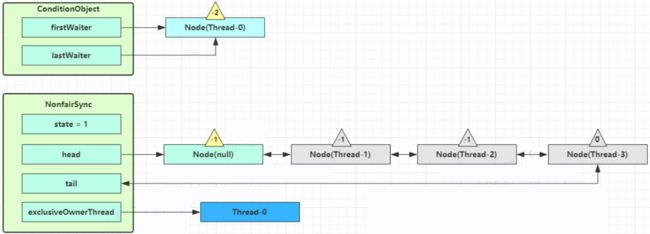
接下来进入 AQS 的 fullyRelease 流程,释放同步器上的锁

unpark AQS 队列中的下一个节点,竞争锁,假设没有其他竞争线程,那么 Thread-1 竞争成功

park 阻塞 Thread-0

signal 流程
假设 Thread-1 要来唤醒 Thread-0

进入 ConditionObject 的 doSignal 流程,取得等待队列中第一个 Node,即 Thread-0 所在 Node
![]()
执行 transferForSignal 流程,将该 Node 加入 AQS 队列尾部,将 Thread-0 的 waitStatus 改为 0,Thread-3 的 waitStatus 改为 -1

Thread-1 释放锁,进入 unlock 流程,略
源码
public class ConditionObject implements Condition, java.io.Serializable {
private static final long serialVersionUID = 1173984872572414699L;
// 第一个等待节点
private transient Node firstWaiter;
// 最后一个等待节点
private transient Node lastWaiter;
public ConditionObject() { }
// ㈠ 添加一个 Node 至等待队列
private Node addConditionWaiter() {
Node t = lastWaiter;
// 所有已取消的 Node 从队列链表删除, 见 ㈡
if (t != null && t.waitStatus != Node.CONDITION) {
unlinkCancelledWaiters();
t = lastWaiter;
}
// 创建一个关联当前线程的新 Node, 添加至队列尾部
Node node = new Node(Thread.currentThread(), Node.CONDITION);
if (t == null)
firstWaiter = node;
else
t.nextWaiter = node;
lastWaiter = node;
return node;
}
// 唤醒 - 将没取消的第一个节点转移至 AQS 队列
private void doSignal(Node first) {
do {
// 已经是尾节点了
if ( (firstWaiter = first.nextWaiter) == null) {
lastWaiter = null;
}
first.nextWaiter = null;
} while (
// 将等待队列中的 Node 转移至 AQS 队列, 不成功且还有节点则继续循环 ㈢
!transferForSignal(first) &&
// 队列还有节点
(first = firstWaiter) != null
);
}
// 外部类方法, 方便阅读, 放在此处
// ㈢ 如果节点状态是取消, 返回 false 表示转移失败, 否则转移成功
final boolean transferForSignal(Node node) {
// 如果状态已经不是 Node.CONDITION, 说明被取消了
if (!compareAndSetWaitStatus(node, Node.CONDITION, 0))
return false;
// 加入 AQS 队列尾部
Node p = enq(node);
int ws = p.waitStatus;
if (
// 上一个节点被取消
ws > 0 ||
// 上一个节点不能设置状态为 Node.SIGNAL
!compareAndSetWaitStatus(p, ws, Node.SIGNAL)
) {
// unpark 取消阻塞, 让线程重新同步状态
LockSupport.unpark(node.thread);
}
return true;
}
// 全部唤醒 - 等待队列的所有节点转移至 AQS 队列
private void doSignalAll(Node first) {
lastWaiter = firstWaiter = null;
do {
Node next = first.nextWaiter;
first.nextWaiter = null;
transferForSignal(first);
first = next;
} while (first != null);
}
// ㈡
private void unlinkCancelledWaiters() {
// ...
}
// 唤醒 - 必须持有锁才能唤醒, 因此 doSignal 内无需考虑加锁
public final void signal() {
if (!isHeldExclusively())
throw new IllegalMonitorStateException();
Node first = firstWaiter;
if (first != null)
doSignal(first);
}
// 全部唤醒 - 必须持有锁才能唤醒, 因此 doSignalAll 内无需考虑加锁
public final void signalAll() {
if (!isHeldExclusively())
throw new IllegalMonitorStateException();
Node first = firstWaiter;
if (first != null)
doSignalAll(first);
}
// 不可打断等待 - 直到被唤醒
public final void awaitUninterruptibly() {
// 添加一个 Node 至等待队列, 见 ㈠
Node node = addConditionWaiter();
// 释放节点持有的锁, 见 ㈣
int savedState = fullyRelease(node);
boolean interrupted = false;
// 如果该节点还没有转移至 AQS 队列, 阻塞
while (!isOnSyncQueue(node)) {
// park 阻塞
LockSupport.park(this);
// 如果被打断, 仅设置打断状态
if (Thread.interrupted())
interrupted = true;
}
// 唤醒后, 尝试竞争锁, 如果失败进入 AQS 队列
if (acquireQueued(node, savedState) || interrupted)
selfInterrupt();
}
// 外部类方法, 方便阅读, 放在此处
// ㈣ 因为某线程可能重入,需要将 state 全部释放
final int fullyRelease(Node node) {
boolean failed = true;
try {
int savedState = getState();
if (release(savedState)) {
failed = false;
return savedState;
} else {
throw new IllegalMonitorStateException();
}
} finally {
if (failed)
node.waitStatus = Node.CANCELLED;
}
}
// 打断模式 - 在退出等待时重新设置打断状态
private static final int REINTERRUPT = 1;
// 打断模式 - 在退出等待时抛出异常
private static final int THROW_IE = -1;
// 判断打断模式
private int checkInterruptWhileWaiting(Node node) {
return Thread.interrupted() ?
(transferAfterCancelledWait(node) ? THROW_IE : REINTERRUPT) :
0;
}
// ㈤ 应用打断模式
private void reportInterruptAfterWait(int interruptMode)
throws InterruptedException {
if (interruptMode == THROW_IE)
throw new InterruptedException();
else if (interruptMode == REINTERRUPT)
selfInterrupt();
}
// 等待 - 直到被唤醒或打断
public final void await() throws InterruptedException {
if (Thread.interrupted()) {
throw new InterruptedException();
}
// 添加一个 Node 至等待队列, 见 ㈠
Node node = addConditionWaiter();
// 释放节点持有的锁
int savedState = fullyRelease(node);
int interruptMode = 0;
// 如果该节点还没有转移至 AQS 队列, 阻塞
while (!isOnSyncQueue(node)) {
// park 阻塞
LockSupport.park(this);
// 如果被打断, 退出等待队列
if ((interruptMode = checkInterruptWhileWaiting(node)) != 0)
break;
}
// 退出等待队列后, 还需要获得 AQS 队列的锁
if (acquireQueued(node, savedState) && interruptMode != THROW_IE)
interruptMode = REINTERRUPT;
// 所有已取消的 Node 从队列链表删除, 见 ㈡
if (node.nextWaiter != null)
unlinkCancelledWaiters();
// 应用打断模式, 见 ㈤
if (interruptMode != 0)
reportInterruptAfterWait(interruptMode);
}
// 等待 - 直到被唤醒或打断或超时
public final long awaitNanos(long nanosTimeout) throws InterruptedException {
if (Thread.interrupted()) {
throw new InterruptedException();
}
// 添加一个 Node 至等待队列, 见 ㈠
Node node = addConditionWaiter();
// 释放节点持有的锁
int savedState = fullyRelease(node);
// 获得最后期限
final long deadline = System.nanoTime() + nanosTimeout;
int interruptMode = 0;
// 如果该节点还没有转移至 AQS 队列, 阻塞
while (!isOnSyncQueue(node)) {
// 已超时, 退出等待队列
if (nanosTimeout <= 0L) {
transferAfterCancelledWait(node);
break;
}
// park 阻塞一定时间, spinForTimeoutThreshold 为 1000 ns
if (nanosTimeout >= spinForTimeoutThreshold)
LockSupport.parkNanos(this, nanosTimeout);
// 如果被打断, 退出等待队列
if ((interruptMode = checkInterruptWhileWaiting(node)) != 0)
break;
nanosTimeout = deadline - System.nanoTime();
}
// 退出等待队列后, 还需要获得 AQS 队列的锁
if (acquireQueued(node, savedState) && interruptMode != THROW_IE)
interruptMode = REINTERRUPT;
// 所有已取消的 Node 从队列链表删除, 见 ㈡
if (node.nextWaiter != null)
unlinkCancelledWaiters();
// 应用打断模式, 见 ㈤
if (interruptMode != 0)
reportInterruptAfterWait(interruptMode);
return deadline - System.nanoTime();
}
// 等待 - 直到被唤醒或打断或超时, 逻辑类似于 awaitNanos
public final boolean awaitUntil(Date deadline) throws InterruptedException {
// ...
}
// 等待 - 直到被唤醒或打断或超时, 逻辑类似于 awaitNanos
public final boolean await(long time, TimeUnit unit) throws InterruptedException {
// ...
}
// 工具方法 省略 ...
}
读写锁原理
1. 图解流程
读写锁用的是同一个 Sycn 同步器,因此等待队列、state 等也是同一个
t1 w.lock,t2 r.lock
1) t1 成功上锁,流程与 ReentrantLock 加锁相比没有特殊之处,不同是写锁状态占了 state 的低 16 位,而读锁使用的是 state 的高 16 位
 2)t2 执行 r.lock,这时进入读锁的 sync.acquireShared(1) 流程,首先会进入 tryAcquireShared 流程。如果有写锁占据,那么 tryAcquireShared 返回 -1 表示失败
2)t2 执行 r.lock,这时进入读锁的 sync.acquireShared(1) 流程,首先会进入 tryAcquireShared 流程。如果有写锁占据,那么 tryAcquireShared 返回 -1 表示失败
tryAcquireShared 返回值表示
- -1 表示失败
- 0 表示成功,但后继节点不会继续唤醒
- 正数表示成功,而且数值是还有几个后继节点需要唤醒,读写锁返回 1
3)这时会进入 sync.doAcquireShared(1) 流程,首先也是调用 addWaiter 添加节点,不同之处在于节点被设置为Node.SHARED 模式而非 Node.EXCLUSIVE 模式,注意此时 t2 仍处于活跃状态

4)t2 会看看自己的节点是不是老二,如果是,还会再次调用 tryAcquireShared(1) 来尝试获取锁
5)如果没有成功,在 doAcquireShared 内 for (; 循环一次,把前驱节点的 waitStatus 改为 -1,再 for (; 循环一次尝试 tryAcquireShared(1) 如果还不成功,那么在 parkAndCheckInterrupt() 处 park

t3 r.lock,t4 w.lock
这种状态下,假设又有 t3 加读锁和 t4 加写锁,这期间 t1 仍然持有锁,就变成了下面的样子

t1 w.unlock
这时会走到写锁的 sync.release(1) 流程,调用 sync.tryRelease(1) 成功,变成下面的样子

接下来执行唤醒流程 sync.unparkSuccessor,即让老二恢复运行,这时 t2 在 doAcquireShared 内 parkAndCheckInterrupt() 处恢复运行
这回再来一次 for (; 执行 tryAcquireShared 成功则让读锁计数加一

这时 t2 已经恢复运行,接下来 t2 调用 setHeadAndPropagate(node, 1),它原本所在节点被置为头节点

事情还没完,在 setHeadAndPropagate 方法内还会检查下一个节点是否是 shared,如果是则调用 doReleaseShared() 将 head 的状态从 -1 改为 0 并唤醒老二,这时 t3 在 doAcquireShared 内 parkAndCheckInterrupt() 处恢复运行
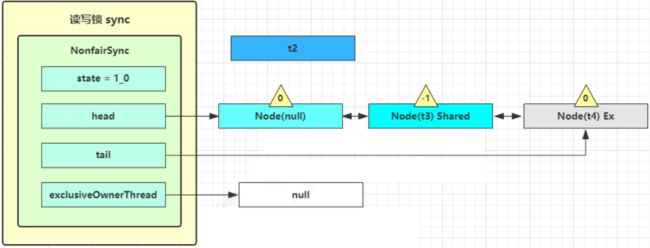
这回再来一次 for (; 执行 tryAcquireShared 成功则让读锁计数加一
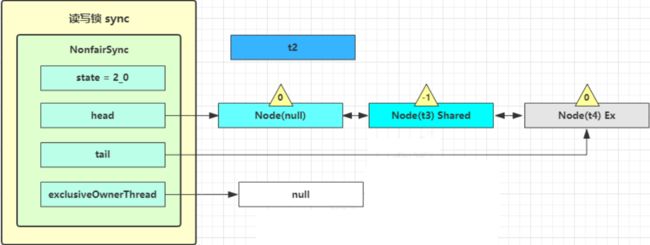
这时 t3 已经恢复运行,接下来 t3 调用 setHeadAndPropagate(node, 1),它原本所在节点被置为头节点

下一个节点不是 shared 了,因此不会继续唤醒 t4 所在节点
t2 r.unlock,t3 r.unlock
t2 进入 sync.releaseShared(1) 中,调用 tryReleaseShared(1) 让计数减一,但由于计数还不为零
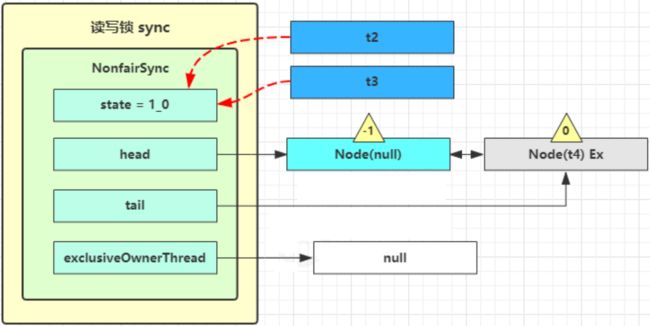
t3 进入 sync.releaseShared(1) 中,调用 tryReleaseShared(1) 让计数减一,这回计数为零了,进入 doReleaseShared() 将头节点从 -1 改为 0 并唤醒老二,即

之后 t4 在 acquireQueued 中 parkAndCheckInterrupt 处恢复运行,再次 for (; 这次自己是老二,并且没有其他 竞争,tryAcquire(1) 成功,修改头结点,流程结束

2. 源码分析
写锁上锁流程
static final class NonfairSync extends Sync {
// ... 省略无关代码
// 外部类 WriteLock 方法, 方便阅读, 放在此处
public void lock() {
sync.acquire(1);
}
// AQS 继承过来的方法, 方便阅读, 放在此处
public final void acquire(int arg) {
if (
// 尝试获得写锁失败
!tryAcquire(arg) &&
// 将当前线程关联到一个 Node 对象上, 模式为独占模式
// 进入 AQS 队列阻塞
acquireQueued(addWaiter(Node.EXCLUSIVE), arg)
) {
selfInterrupt();
}
}
// Sync 继承过来的方法, 方便阅读, 放在此处
protected final boolean tryAcquire(int acquires) {
// 获得低 16 位, 代表写锁的 state 计数
Thread current = Thread.currentThread();
int c = getState();
int w = exclusiveCount(c);
if (c != 0) {
if (
// c != 0 and w == 0 表示有读锁, 或者
w == 0 ||
// 如果 exclusiveOwnerThread 不是自己
current != getExclusiveOwnerThread()
) {
// 获得锁失败
return false;
}
// 写锁计数超过低 16 位, 报异常
if (w + exclusiveCount(acquires) > MAX_COUNT)
throw new Error("Maximum lock count exceeded");
// 写锁重入, 获得锁成功
setState(c + acquires);
return true;
}
if (
// 判断写锁是否该阻塞, 或者
writerShouldBlock() ||
// 尝试更改计数失败
!compareAndSetState(c, c + acquires)
) {
// 获得锁失败
return false;
}
// 获得锁成功
setExclusiveOwnerThread(current);
return true;
}
// 非公平锁 writerShouldBlock 总是返回 false, 无需阻塞
final boolean writerShouldBlock() {
return false;
}
}
写锁释放流程
static final class NonfairSync extends Sync {
// ... 省略无关代码
// WriteLock 方法, 方便阅读, 放在此处
public void unlock() {
sync.release(1);
}
// AQS 继承过来的方法, 方便阅读, 放在此处
public final boolean release(int arg) {
// 尝试释放写锁成功
if (tryRelease(arg)) {
// unpark AQS 中等待的线程
Node h = head;
if (h != null && h.waitStatus != 0)
unparkSuccessor(h);
return true;
}
return false;
}
// Sync 继承过来的方法, 方便阅读, 放在此处
protected final boolean tryRelease(int releases) {
if (!isHeldExclusively())
throw new IllegalMonitorStateException();
int nextc = getState() - releases;
// 因为可重入的原因, 写锁计数为 0, 才算释放成功
boolean free = exclusiveCount(nextc) == 0;
if (free) {
setExclusiveOwnerThread(null);
}
setState(nextc);
return free;
}
}
读锁上锁流程
static final class NonfairSync extends Sync {
// ReadLock 方法, 方便阅读, 放在此处
public void lock() {
sync.acquireShared(1);
}
// AQS 继承过来的方法, 方便阅读, 放在此处
public final void acquireShared(int arg) {
// tryAcquireShared 返回负数, 表示获取读锁失败
if (tryAcquireShared(arg) < 0) {
doAcquireShared(arg);
}
}
// Sync 继承过来的方法, 方便阅读, 放在此处
protected final int tryAcquireShared(int unused) {
Thread current = Thread.currentThread();
int c = getState();
// 如果是其它线程持有写锁, 获取读锁失败
if (
exclusiveCount(c) != 0 &&
getExclusiveOwnerThread() != current
) {
return -1;
}
int r = sharedCount(c);
if (
// 读锁不该阻塞(如果老二是写锁,读锁该阻塞), 并且
!readerShouldBlock() &&
// 小于读锁计数, 并且
r < MAX_COUNT &&
// 尝试增加计数成功
compareAndSetState(c, c + SHARED_UNIT)
) {
// ... 省略不重要的代码
return 1;
}
return fullTryAcquireShared(current);
}
// 非公平锁 readerShouldBlock 看 AQS 队列中第一个节点是否是写锁
// true 则该阻塞, false 则不阻塞
final boolean readerShouldBlock() {
return apparentlyFirstQueuedIsExclusive();
}
// AQS 继承过来的方法, 方便阅读, 放在此处
// 与 tryAcquireShared 功能类似, 但会不断尝试 for (;;) 获取读锁, 执行过程中无阻塞
final int fullTryAcquireShared(Thread current) {
HoldCounter rh = null;
for (;;) {
int c = getState();
if (exclusiveCount(c) != 0) {
if (getExclusiveOwnerThread() != current)
return -1;
} else if (readerShouldBlock()) {
// ... 省略不重要的代码
}
if (sharedCount(c) == MAX_COUNT)
throw new Error("Maximum lock count exceeded");
if (compareAndSetState(c, c + SHARED_UNIT)) {
// ... 省略不重要的代码
return 1;
}
}
}
// AQS 继承过来的方法, 方便阅读, 放在此处
private void doAcquireShared(int arg) {
// 将当前线程关联到一个 Node 对象上, 模式为共享模式
final Node node = addWaiter(Node.SHARED);
boolean failed = true;
try {
boolean interrupted = false;
for (;;) {
final Node p = node.predecessor();
if (p == head) {
// 再一次尝试获取读锁
int r = tryAcquireShared(arg);
// 成功
if (r >= 0) {
// ㈠
// r 表示可用资源数, 在这里总是 1 允许传播
//(唤醒 AQS 中下一个 Share 节点)
setHeadAndPropagate(node, r);
p.next = null; // help GC
if (interrupted)
selfInterrupt();
failed = false;
return;
}
}
if (
// 是否在获取读锁失败时阻塞(前一个阶段 waitStatus == Node.SIGNAL)
shouldParkAfterFailedAcquire(p, node) &&
// park 当前线程
parkAndCheckInterrupt()
) {
interrupted = true;
}
}
} finally {
if (failed)
cancelAcquire(node);
}
}
// ㈠ AQS 继承过来的方法, 方便阅读, 放在此处
private void setHeadAndPropagate(Node node, int propagate) {
Node h = head; // Record old head for check below
// 设置自己为 head
setHead(node);
// propagate 表示有共享资源(例如共享读锁或信号量)
// 原 head waitStatus == Node.SIGNAL 或 Node.PROPAGATE
// 现在 head waitStatus == Node.SIGNAL 或 Node.PROPAGATE
if (propagate > 0 || h == null || h.waitStatus < 0 ||
(h = head) == null || h.waitStatus < 0) {
Node s = node.next;
// 如果是最后一个节点或者是等待共享读锁的节点
if (s == null || s.isShared()) {
// 进入 ㈡
doReleaseShared();
}
}
}
// ㈡ AQS 继承过来的方法, 方便阅读, 放在此处
private void doReleaseShared() {
// 如果 head.waitStatus == Node.SIGNAL ==> 0 成功, 下一个节点 unpark
// 如果 head.waitStatus == 0 ==> Node.PROPAGATE, 为了解决 bug, 见后面分析
for (;;) {
Node h = head;
// 队列还有节点
if (h != null && h != tail) {
int ws = h.waitStatus;
if (ws == Node.SIGNAL) {
if (!compareAndSetWaitStatus(h, Node.SIGNAL, 0))
continue; // loop to recheck cases
// 下一个节点 unpark 如果成功获取读锁
// 并且下下个节点还是 shared, 继续 doReleaseShared
unparkSuccessor(h);
}
else if (ws == 0 &&
!compareAndSetWaitStatus(h, 0, Node.PROPAGATE))
continue; // loop on failed CAS
}
if (h == head) // loop if head changed
break;
}
}
}
读锁释放流程
static final class NonfairSync extends Sync {
// ReadLock 方法, 方便阅读, 放在此处
public void unlock() {
sync.releaseShared(1);
}
// AQS 继承过来的方法, 方便阅读, 放在此处
public final boolean releaseShared(int arg) {
if (tryReleaseShared(arg)) {
doReleaseShared();
return true;
}
return false;
}
// Sync 继承过来的方法, 方便阅读, 放在此处
protected final boolean tryReleaseShared(int unused) {
// ... 省略不重要的代码
for (;;) {
int c = getState();
int nextc = c - SHARED_UNIT;
if (compareAndSetState(c, nextc)) {
// 读锁的计数不会影响其它获取读锁线程, 但会影响其它获取写锁线程
// 计数为 0 才是真正释放
return nextc == 0;
}
}
}
// AQS 继承过来的方法, 方便阅读, 放在此处
private void doReleaseShared() {
// 如果 head.waitStatus == Node.SIGNAL ==> 0 成功, 下一个节点 unpark
// 如果 head.waitStatus == 0 ==> Node.PROPAGATE
for (;;) {
Node h = head;
if (h != null && h != tail) {
int ws = h.waitStatus;
// 如果有其它线程也在释放读锁,那么需要将 waitStatus 先改为 0
// 防止 unparkSuccessor 被多次执行
if (ws == Node.SIGNAL) {
if (!compareAndSetWaitStatus(h, Node.SIGNAL, 0))
continue; // loop to recheck cases
unparkSuccessor(h);
}
// 如果已经是 0 了,改为 -3,用来解决传播性,见后文信号量 bug 分析
else if (ws == 0 &&
!compareAndSetWaitStatus(h, 0, Node.PROPAGATE))
continue; // loop on failed CAS
}
if (h == head) // loop if head changed
break;
}
}
}
Semaphore 原理
1. 加锁解锁流程
Semaphore 有点像一个停车场,permits 就好像停车位数量,当线程获得了 permits 就像是获得了停车位,然后停车场显示空余车位减一
刚开始,permits(state)为 3,这时 5 个线程来获取资源

假设其中 Thread-1,Thread-2,Thread-4 cas 竞争成功,而 Thread-0 和 Thread-3 竞争失败,进入 AQS 队列 park 阻塞

这时 Thread-4 释放了 permits,状态如下

接下来 Thread-0 竞争成功,permits 再次设置为 0,设置自己为 head 节点,断开原来的 head 节点,unpark 接下来的 Thread-3 节点,但由于 permits 是 0,因此 Thread-3 在尝试不成功后再次进入 park 状态

2. 源码分析
static final class NonfairSync extends Sync {
private static final long serialVersionUID = -2694183684443567898L;
NonfairSync(int permits) {
// permits 即 state
super(permits);
}
// Semaphore 方法, 方便阅读, 放在此处
public void acquire() throws InterruptedException {
sync.acquireSharedInterruptibly(1);
}
// AQS 继承过来的方法, 方便阅读, 放在此处
public final void acquireSharedInterruptibly(int arg)
throws InterruptedException {
if (Thread.interrupted())
throw new InterruptedException();
if (tryAcquireShared(arg) < 0)
doAcquireSharedInterruptibly(arg);
}
// 尝试获得共享锁
protected int tryAcquireShared(int acquires) {
return nonfairTryAcquireShared(acquires);
}
// Sync 继承过来的方法, 方便阅读, 放在此处
final int nonfairTryAcquireShared(int acquires) {
for (; ; ) {
int available = getState();
int remaining = available - acquires;
if (
// 如果许可已经用完, 返回负数, 表示获取失败, 进入 doAcquireSharedInterruptibly
remaining < 0 ||
// 如果 cas 重试成功, 返回正数, 表示获取成功
compareAndSetState(available, remaining)
) {
return remaining;
}
}
}
// AQS 继承过来的方法, 方便阅读, 放在此处
private void doAcquireSharedInterruptibly(int arg) throws InterruptedException {
final Node node = addWaiter(Node.SHARED);
boolean failed = true;
try {
for (; ; ) {
final Node p = node.predecessor();
if (p == head) {
// 再次尝试获取许可
int r = tryAcquireShared(arg);
if (r >= 0) {
// 成功后本线程出队(AQS), 所在 Node设置为 head
// 如果 head.waitStatus == Node.SIGNAL ==> 0 成功, 下一个节点 unpark
// 如果 head.waitStatus == 0 ==> Node.PROPAGATE
// r 表示可用资源数, 为 0 则不会继续传播
setHeadAndPropagate(node, r);
p.next = null; // help GC
failed = false;
return;
}
}
// 不成功, 设置上一个节点 waitStatus = Node.SIGNAL, 下轮进入 park 阻塞
if (shouldParkAfterFailedAcquire(p, node) &&
parkAndCheckInterrupt())
throw new InterruptedException();
}
} finally {
if (failed)
cancelAcquire(node);
}
}
// Semaphore 方法, 方便阅读, 放在此处
public void release() {
sync.releaseShared(1);
}
// AQS 继承过来的方法, 方便阅读, 放在此处
public final boolean releaseShared(int arg) {
if (tryReleaseShared(arg)) {
doReleaseShared();
return true;
}
return false;
}
// Sync 继承过来的方法, 方便阅读, 放在此处
protected final boolean tryReleaseShared(int releases) {
for (; ; ) {
int current = getState();
int next = current + releases;
if (next < current) // overflow
throw new Error("Maximum permit count exceeded");
if (compareAndSetState(current, next))
return true;
}
}
}
3. 为什么要有 PROPAGATE
早期有 bug
- releaseShared 方法
public final boolean releaseShared(int arg) {
if (tryReleaseShared(arg)) {
Node h = head;
if (h != null && h.waitStatus != 0)
unparkSuccessor(h);
return true;
}
return false;
}
- doAcquireShared 方法
private void doAcquireShared(int arg) {
final Node node = addWaiter(Node.SHARED);
boolean failed = true;
try {
boolean interrupted = false;
for (;;) {
final Node p = node.predecessor();
if (p == head) {
int r = tryAcquireShared(arg);
if (r >= 0) {
// 这里会有空档
setHeadAndPropagate(node, r);
p.next = null; // help GC
if (interrupted)
selfInterrupt();
failed = false;
return;
}
}
if (shouldParkAfterFailedAcquire(p, node) &&
parkAndCheckInterrupt())
interrupted = true;
}
} finally {
if (failed)
cancelAcquire(node);
}
}
- setHeadAndPropagate 方法
private void setHeadAndPropagate(Node node, int propagate) {
setHead(node);
// 有空闲资源
if (propagate > 0 && node.waitStatus != 0) {
Node s = node.next;
// 下一个
if (s == null || s.isShared())
unparkSuccessor(node);
}
}
- 假设存在某次循环中队列里排队的结点情况为 head(-1)->t1(-1)->t2(-1)
- 假设存在将要信号量释放的 T3 和 T4,释放顺序为先 T3 后 T4
正常流程
产生 bug 的情况
修复前版本执行流程
- T3 调用 releaseShared(1),直接调用了 unparkSuccessor(head),head 的等待状态从 -1 变为 0
- T1 由于 T3 释放信号量被唤醒,调用 tryAcquireShared,假设返回值为 0(获取锁成功,但没有剩余资源量)
- T4 调用 releaseShared(1),此时 head.waitStatus 为 0(此时读到的 head 和 1 中为同一个head),不满足条件,因此不调用 unparkSuccessor(head)
- T1 获取信号量成功,调用 setHeadAndPropagate 时,因为不满足 propagate > 0(2 的返回值也就是 propagate(剩余资源量) == 0),从而不会唤醒后继结点, T2 线程得不到唤醒
bug 修复后
private void setHeadAndPropagate(Node node, int propagate) {
Node h = head; // Record old head for check below
// 设置自己为 head
setHead(node);
// propagate 表示有共享资源(例如共享读锁或信号量)
// 原 head waitStatus == Node.SIGNAL 或 Node.PROPAGATE
// 现在 head waitStatus == Node.SIGNAL 或 Node.PROPAGATE
if (propagate > 0 || h == null || h.waitStatus < 0 ||
(h = head) == null || h.waitStatus < 0) {
Node s = node.next;
// 如果是最后一个节点或者是等待共享读锁的节点
if (s == null || s.isShared()) {
doReleaseShared();
}
}
}
private void doReleaseShared() {
// 如果 head.waitStatus == Node.SIGNAL ==> 0 成功, 下一个节点 unpark
// 如果 head.waitStatus == 0 ==> Node.PROPAGATE
for (;;) {
Node h = head;
if (h != null && h != tail) {
int ws = h.waitStatus;
if (ws == Node.SIGNAL) {
if (!compareAndSetWaitStatus(h, Node.SIGNAL, 0))
continue; // loop to recheck cases
unparkSuccessor(h);
}
else if (ws == 0 &&
!compareAndSetWaitStatus(h, 0, Node.PROPAGATE))
continue; // loop on failed CAS
}
if (h == head) // loop if head changed
break;
}
}
- T3 调用 releaseShared(),直接调用了 unparkSuccessor(head),head 的等待状态从 -1 变为 0
- T1 由于 T3 释放信号量被唤醒,调用 tryAcquireShared,假设返回值为 0(获取锁成功,但没有剩余资源量)
- T4 调用 releaseShared(),此时 head.waitStatus 为 0(此时读到的 head 和 1 中为同一个 head),调用 doReleaseShared() 将等待状态置为 PROPAGATE(-3)
- T1 获取信号量成功,调用 setHeadAndPropagate 时,读到 h.waitStatus < 0,从而调用 doReleaseShared() 唤醒 T2
ConcurrentHashMap 原理
1. JDK 7 HashMap 并发死链
测试代码
注意
- 要在 JDK 7 下运行,否则扩容机制和 hash 的计算方法都变了
- 以下测试代码是精心准备的,不要随便改动
public static void main(String[] args) {
// 测试 java 7 中哪些数字的 hash 结果相等
System.out.println("长度为16时,桶下标为1的key");
for (int i = 0; i < 64; i++) {
if (hash(i) % 16 == 1) {
System.out.println(i);
}
}
System.out.println("长度为32时,桶下标为1的key");
for (int i = 0; i < 64; i++) {
if (hash(i) % 32 == 1) {
System.out.println(i);
}
}
// 1, 35, 16, 50 当大小为16时,它们在一个桶内
final HashMap<Integer, Integer> map = new HashMap<Integer, Integer>();
// 放 12 个元素
map.put(2, null);
map.put(3, null);
map.put(4, null);
map.put(5, null);
map.put(6, null);
map.put(7, null);
map.put(8, null);
map.put(9, null);
map.put(10, null);
map.put(16, null);
map.put(35, null);
map.put(1, null);
System.out.println("扩容前大小[main]:"+map.size());
new Thread() {
@Override
public void run() {
// 放第 13 个元素, 发生扩容
map.put(50, null);
System.out.println("扩容后大小[Thread-0]:"+map.size());
}
}.start();
new Thread() {
@Override
public void run() {
// 放第 13 个元素, 发生扩容
map.put(50, null);
System.out.println("扩容后大小[Thread-1]:"+map.size());
}
}.start();
}
final static int hash(Object k) {
int h = 0;
if (0 != h && k instanceof String) {
return sun.misc.Hashing.stringHash32((String) k);
}
h ^= k.hashCode();
h ^= (h >>> 20) ^ (h >>> 12);
return h ^ (h >>> 7) ^ (h >>> 4);
}
死链复现
调试工具使用 idea
在 HashMap 源码 590 行加断点
int newCapacity = newTable.length;
断点的条件如下,目的是让 HashMap 在扩容为 32 时,并且线程为 Thread-0 或 Thread-1 时停下来
newTable.length==32 &&
(
Thread.currentThread().getName().equals("Thread-0")||
Thread.currentThread().getName().equals("Thread-1")
)
断点暂停方式选择 Thread,否则在调试 Thread-0 时,Thread-1 无法恢复运行
运行代码,程序在预料的断点位置停了下来,输出
长度为16时,桶下标为1的key
1
16
35
50
长度为32时,桶下标为1的key
1
35
扩容前大小[main]:12
接下来进入扩容流程调试
在 HashMap 源码 594 行加断点
Entry<K,V> next = e.next; // 593
if (rehash) // 594
// ...
这是为了观察 e 节点和 next 节点的状态,Thread-0 单步执行到 594 行,再 594 处再添加一个断点(条件 Thread.currentThread().getName().equals(“Thread-0”))
这时可以在 Variables 面板观察到 e 和 next 变量,使用 view as -> Object 查看节点状态
e (1)->(35)->(16)->null
next (35)->(16)->null
在 Threads 面板选中 Thread-1 恢复运行,可以看到控制台输出新的内容如下,Thread-1 扩容已完成
newTable[1] (35)->(1)->null
扩容后大小:13
这时 Thread-0 还停在 594 处, Variables 面板变量的状态已经变化为
e (1)->null
next (35)->(1)->null
为什么呢,因为 Thread-1 扩容时链表也是后加入的元素放入链表头,因此链表就倒过来了,但 Thread-1 虽然结果正确,但它结束后 Thread-0 还要继续运行
接下来就可以单步调试(F8)观察死链的产生了
下一轮循环到 594,将 e 搬迁到 newTable 链表头
newTable[1] (1)->null
e (35)->(1)->null
next (1)->null
下一轮循环到 594,将 e 搬迁到 newTable 链表头
newTable[1] (35)->(1)->null
e (1)->null
next null
再看看源码
e.next = newTable[1];
// 这时 e (1,35)
// 而 newTable[1] (35,1)->(1,35) 因为是同一个对象
newTable[1] = e;
// 再尝试将 e 作为链表头, 死链已成
e = next;
// 虽然 next 是 null, 会进入下一个链表的复制, 但死链已经形成了
源码分析
HashMap 的并发死链发生在扩容时
// 将 table 迁移至 newTable
void transfer(Entry[] newTable, boolean rehash) {
int newCapacity = newTable.length;
for (Entry<K,V> e : table) {
while(null != e) {
Entry<K,V> next = e.next;
// 1 处
if (rehash) {
e.hash = null == e.key ? 0 : hash(e.key);
}
int i = indexFor(e.hash, newCapacity);
// 2 处
// 将新元素加入 newTable[i], 原 newTable[i] 作为新元素的 next
e.next = newTable[i];
newTable[i] = e;
e = next;
}
}
}
假设 map 中初始元素是
原始链表,格式:[下标] (key,next)
[1] (1,35)->(35,16)->(16,null)
线程 a 执行到 1 处 ,此时局部变量 e 为 (1,35),而局部变量 next 为 (35,16) 线程 a 挂起
线程 b 开始执行
第一次循环
[1] (1,null)
第二次循环
[1] (35,1)->(1,null)
第三次循环
[1] (35,1)->(1,null)
[17] (16,null)
切换回线程 a,此时局部变量 e 和 next 被恢复,引用没变但内容变了:e 的内容被改为 (1,null),而 next 的内
容被改为 (35,1) 并链向 (1,null)
第一次循环
[1] (1,null)
第二次循环,注意这时 e 是 (35,1) 并链向 (1,null) 所以 next 又是 (1,null)
[1] (35,1)->(1,null)
第三次循环,e 是 (1,null),而 next 是 null,但 e 被放入链表头,这样 e.next 变成了 35 (2 处)
[1] (1,35)->(35,1)->(1,35)
已经是死链了
小结
- 究其原因,是因为在多线程环境下使用了非线程安全的 map 集合
- JDK 8 虽然将扩容算法做了调整,不再将元素加入链表头(而是保持与扩容前一样的顺序),但仍不意味着能够在多线程环境下能够安全扩容,还会出现其它问题(如扩容丢数据)
2. JDK 8 ConcurrentHashMap
重要属性和内部类
// 默认为 0
// 当初始化时, 为 -1
// 当扩容时, 为 -(1 + 扩容线程数)
// 当初始化或扩容完成后,为 下一次的扩容的阈值大小
private transient volatile int sizeCtl;
// 整个 ConcurrentHashMap 就是一个 Node[]
static class Node<K,V> implements Map.Entry<K,V> {}
// hash 表
transient volatile Node<K,V>[] table;
// 扩容时的 新 hash 表
private transient volatile Node<K,V>[] nextTable;
// 扩容时如果某个 bin 迁移完毕, 用 ForwardingNode 作为旧 table bin 的头结点
static final class ForwardingNode<K,V> extends Node<K,V> {}
// 用在 compute 以及 computeIfAbsent 时, 用来占位, 计算完成后替换为普通 Node
static final class ReservationNode<K,V> extends Node<K,V> {}
// 作为 treebin 的头节点, 存储 root 和 first
static final class TreeBin<K,V> extends Node<K,V> {}
// 作为 treebin 的节点, 存储 parent, left, right
static final class TreeNode<K,V> extends Node<K,V> {}
重要方法
// 获取 Node[] 中第 i 个 Node
static final <K, V> Node<K, V> tabAt(Node<K, V>[] tab, int i)
// cas 修改 Node[] 中第 i 个 Node 的值, c 为旧值, v 为新值
static final <K, V> boolean casTabAt(Node<K, V>[] tab, int i, Node<K, V> c, Node<K, V> v)
// 直接修改 Node[] 中第 i 个 Node 的值, v 为新值
static final <K, V> void setTabAt(Node<K, V>[] tab, int i, Node<K, V> v)
构造器分析
可以看到实现了懒惰初始化,在构造方法中仅仅计算了 table 的大小,以后在第一次使用时才会真正创建
public ConcurrentHashMap(int initialCapacity, float loadFactor, int concurrencyLevel) {
if (!(loadFactor > 0.0f) || initialCapacity < 0 || concurrencyLevel <= 0)
throw new IllegalArgumentException();
if (initialCapacity < concurrencyLevel) // Use at least as many bins
initialCapacity = concurrencyLevel; // as estimated threads
long size = (long)(1.0 + (long)initialCapacity / loadFactor);
// tableSizeFor 仍然是保证计算的大小是 2^n, 即 16,32,64 ...
int cap = (size >= (long)MAXIMUM_CAPACITY) ?
MAXIMUM_CAPACITY : tableSizeFor((int)size);
this.sizeCtl = cap;
}
get 流程
public V get(Object key) {
Node<K,V>[] tab; Node<K,V> e, p; int n, eh; K ek;
// spread 方法能确保返回结果是正数
int h = spread(key.hashCode());
if ((tab = table) != null && (n = tab.length) > 0 &&
(e = tabAt(tab, (n - 1) & h)) != null) {
// 如果头结点已经是要查找的 key
if ((eh = e.hash) == h) {
if ((ek = e.key) == key || (ek != null && key.equals(ek)))
return e.val;
}
// hash 为负数表示该 bin 在扩容中或是 treebin, 这时调用 find 方法来查找
else if (eh < 0)
return (p = e.find(h, key)) != null ? p.val : null;
// 正常遍历链表, 用 equals 比较
while ((e = e.next) != null) {
if (e.hash == h &&
((ek = e.key) == key || (ek != null && key.equals(ek))))
return e.val;
}
}
return null;
}
put 流程
以下数组简称(table),链表简称(bin)
public V put(K key, V value) {
return putVal(key, value, false);
}
// onlyIfAbsent 只有缺失才赋值
final V putVal(K key, V value, boolean onlyIfAbsent) {
if (key == null || value == null) throw new NullPointerException();
// 其中 spread 方法会综合高位低位, 具有更好的 hash 性
int hash = spread(key.hashCode());
int binCount = 0;
for (Node<K,V>[] tab = table;;) {
// f 是链表头节点
// fh 是链表头结点的 hash
// i 是链表在 table 中的下标
Node<K,V> f; int n, i, fh;
// 要创建 table
if (tab == null || (n = tab.length) == 0)
// 初始化 table 使用了 cas, 无需 synchronized 创建成功, 进入下一轮循环
tab = initTable();
// 要创建链表头节点
else if ((f = tabAt(tab, i = (n - 1) & hash)) == null) {
// 添加链表头使用了 cas, 无需 synchronized
if (casTabAt(tab, i, null,
new Node<K,V>(hash, key, value, null)))
break;
}
// 帮忙扩容
else if ((fh = f.hash) == MOVED)
// 帮忙之后, 进入下一轮循环
tab = helpTransfer(tab, f);
else {
V oldVal = null;
// 锁住链表头节点
synchronized (f) {
// 再次确认链表头节点没有被移动
if (tabAt(tab, i) == f) {
// 链表
if (fh >= 0) {
binCount = 1;
// 遍历链表
for (Node<K,V> e = f;; ++binCount) {
K ek;
// 找到相同的 key
if (e.hash == hash &&
((ek = e.key) == key ||
(ek != null && key.equals(ek)))) {
oldVal = e.val;
// 更新
if (!onlyIfAbsent)
e.val = value;
break;
}
Node<K,V> pred = e;
// 已经是最后的节点了, 新增 Node, 追加至链表尾
if ((e = e.next) == null) {
pred.next = new Node<K,V>(hash, key,
value, null);
break;
}
}
}
// 红黑树
else if (f instanceof TreeBin) {
Node<K,V> p;
binCount = 2;
// putTreeVal 会看 key 是否已经在树中, 是, 则返回对应的 TreeNode
if ((p = ((TreeBin<K,V>)f).putTreeVal(hash, key,
value)) != null) {
oldVal = p.val;
if (!onlyIfAbsent)
p.val = value;
}
}
}
// 释放链表头节点的锁
}
if (binCount != 0) {
if (binCount >= TREEIFY_THRESHOLD)
// 如果链表长度 >= 树化阈值(8), 进行链表转为红黑树
treeifyBin(tab, i);
if (oldVal != null)
return oldVal;
break;
}
}
}
// 增加 size 计数
addCount(1L, binCount);
return null;
}
private final Node<K,V>[] initTable() {
Node<K,V>[] tab; int sc;
while ((tab = table) == null || tab.length == 0) {
if ((sc = sizeCtl) < 0)
Thread.yield();
// 尝试将 sizeCtl 设置为 -1(表示初始化 table)
else if (U.compareAndSwapInt(this, SIZECTL, sc, -1)) {
// 获得锁, 创建 table, 这时其它线程会在 while() 循环中 yield 直至 table 创建
try {
if ((tab = table) == null || tab.length == 0) {
int n = (sc > 0) ? sc : DEFAULT_CAPACITY;
Node<K,V>[] nt = (Node<K,V>[])new Node<?,?>[n];
table = tab = nt;
sc = n - (n >>> 2);
}
} finally {
sizeCtl = sc;
}
break;
}
}
return tab;
}
// check 是之前 binCount 的个数
private final void addCount(long x, int check) {
CounterCell[] as; long b, s;
if (
// 已经有了 counterCells, 向 cell 累加
(as = counterCells) != null ||
// 还没有, 向 baseCount 累加
!U.compareAndSwapLong(this, BASECOUNT, b = baseCount, s = b + x)
) {
CounterCell a; long v; int m;
boolean uncontended = true;
if (
// 还没有 counterCells
as == null || (m = as.length - 1) < 0 ||
// 还没有 cell
(a = as[ThreadLocalRandom.getProbe() & m]) == null ||
// cell cas 增加计数失败
!(uncontended = U.compareAndSwapLong(a, CELLVALUE, v = a.value, v + x))
) {
// 创建累加单元数组和cell, 累加重试
fullAddCount(x, uncontended);
return;
}
if (check <= 1)
return;
// 获取元素个数
s = sumCount();
}
if (check >= 0) {
Node<K,V>[] tab, nt; int n, sc;
while (s >= (long)(sc = sizeCtl) && (tab = table) != null &&
(n = tab.length) < MAXIMUM_CAPACITY) {
int rs = resizeStamp(n);
if (sc < 0) {
if ((sc >>> RESIZE_STAMP_SHIFT) != rs || sc == rs + 1 ||
sc == rs + MAX_RESIZERS || (nt = nextTable) == null ||
transferIndex <= 0)
break;
// newtable 已经创建了,帮忙扩容
if (U.compareAndSwapInt(this, SIZECTL, sc, sc + 1))
transfer(tab, nt);
}
// 需要扩容,这时 newtable 未创建
else if (U.compareAndSwapInt(this, SIZECTL, sc,
(rs << RESIZE_STAMP_SHIFT) + 2))
transfer(tab, null);
s = sumCount();
}
}
}
size 计算流程
size 计算实际发生在 put,remove 改变集合元素的操作之中
- 没有竞争发生,向 baseCount 累加计数
- 有竞争发生,新建 counterCells,向其中的一个 cell 累加计数
- counterCells 初始有两个 cell
- 如果计数竞争比较激烈,会创建新的 cell 来累加计数
public int size() {
long n = sumCount();
return ((n < 0L) ? 0 :
(n > (long)Integer.MAX_VALUE) ? Integer.MAX_VALUE :
(int)n);
}
final long sumCount() {
CounterCell[] as = counterCells; CounterCell a;
// 将 baseCount 计数与所有 cell 计数累加
long sum = baseCount;
if (as != null) {
for (int i = 0; i < as.length; ++i) {
if ((a = as[i]) != null)
sum += a.value;
}
}
return sum;
}
Java 8 数组(Node) +( 链表 Node | 红黑树 TreeNode ) 以下数组简称(table),链表简称(bin)
- 初始化,使用 cas 来保证并发安全,懒惰初始化 table
- 树化,当 table.length < 64 时,先尝试扩容,超过 64 时,并且 bin.length > 8 时,会将链表树化,树化过程会用 synchronized 锁住链表头
- put,如果该 bin 尚未创建,只需要使用 cas 创建 bin;如果已经有了,锁住链表头进行后续 put 操作,元素添加至 bin 的尾部
- get,无锁操作仅需要保证可见性,扩容过程中 get 操作拿到的是 ForwardingNode 它会让 get 操作在新table 进行搜索
- 扩容,扩容时以 bin 为单位进行,需要对 bin 进行 synchronized,但这时妙的是其它竞争线程也不是无事可做,它们会帮助把其它 bin 进行扩容,扩容时平均只有 1/6 的节点会把复制到新 table 中
- size,元素个数保存在 baseCount 中,并发时的个数变动保存在 CounterCell[] 当中。最后统计数量时累加即可
源码分析 http://www.importnew.com/28263.html
其它实现 https://github.com/boundary/high-scale-lib
3. JDK 7 ConcurrentHashMap
它维护了一个 segment 数组,每个 segment 对应一把锁
- 优点:如果多个线程访问不同的 segment,实际是没有冲突的,这与 jdk8 中是类似的
- 缺点:Segments 数组默认大小为16,这个容量初始化指定后就不能改变了,并且不是懒惰初始化
构造器分析
public ConcurrentHashMap(int initialCapacity, float loadFactor, int concurrencyLevel) {
if (!(loadFactor > 0) || initialCapacity < 0 || concurrencyLevel <= 0)
throw new IllegalArgumentException();
if (concurrencyLevel > MAX_SEGMENTS)
concurrencyLevel = MAX_SEGMENTS;
// ssize 必须是 2^n, 即 2, 4, 8, 16 ... 表示了 segments 数组的大小
int sshift = 0;
int ssize = 1;
while (ssize < concurrencyLevel) {
++sshift;
ssize <<= 1;
}
// segmentShift 默认是 32 - 4 = 28
this.segmentShift = 32 - sshift;
// segmentMask 默认是 15 即 0000 0000 0000 1111
this.segmentMask = ssize - 1;
if (initialCapacity > MAXIMUM_CAPACITY)
initialCapacity = MAXIMUM_CAPACITY;
int c = initialCapacity / ssize;
if (c * ssize < initialCapacity)
++c;
int cap = MIN_SEGMENT_TABLE_CAPACITY;
while (cap < c)
cap <<= 1;
// 创建 segments and segments[0]
Segment<K,V> s0 =
new Segment<K,V>(loadFactor, (int)(cap * loadFactor),
(HashEntry<K,V>[])new HashEntry[cap]);
Segment<K,V>[] ss = (Segment<K,V>[])new Segment[ssize];
UNSAFE.putOrderedObject(ss, SBASE, s0); // ordered write of segments[0]
this.segments = ss;
}
构造完成,如下图所示

可以看到 ConcurrentHashMap 没有实现懒惰初始化,空间占用不友好
其中 this.segmentShift 和 this.segmentMask 的作用是决定将 key 的 hash 结果匹配到哪个 segment
例如,根据某一 hash 值求 segment 位置,先将高位向低位移动 this.segmentShift 位

结果再与 this.segmentMask 做位于运算,最终得到 1010 即下标为 10 的 segment

put 流程
public V put(K key, V value) {
Segment<K,V> s;
if (value == null)
throw new NullPointerException();
int hash = hash(key);
// 计算出 segment 下标
int j = (hash >>> segmentShift) & segmentMask;
// 获得 segment 对象, 判断是否为 null, 是则创建该 segment
if ((s = (Segment<K,V>)UNSAFE.getObject
(segments, (j << SSHIFT) + SBASE)) == null) {
// 这时不能确定是否真的为 null, 因为其它线程也发现该 segment 为 null,
// 因此在 ensureSegment 里用 cas 方式保证该 segment 安全性
s = ensureSegment(j);
}
// 进入 segment 的put 流程
return s.put(key, hash, value, false);
}
segment 继承了可重入锁(ReentrantLock),它的 put 方法为
final V put(K key, int hash, V value, boolean onlyIfAbsent) {
// 尝试加锁
HashEntry<K,V> node = tryLock() ? null :
// 如果不成功, 进入 scanAndLockForPut 流程
// 如果是多核 cpu 最多 tryLock 64 次, 进入 lock 流程
// 在尝试期间, 还可以顺便看该节点在链表中有没有, 如果没有顺便创建出来
scanAndLockForPut(key, hash, value);
// 执行到这里 segment 已经被成功加锁, 可以安全执行
V oldValue;
try {
HashEntry<K,V>[] tab = table;
int index = (tab.length - 1) & hash;
HashEntry<K,V> first = entryAt(tab, index);
for (HashEntry<K,V> e = first;;) {
if (e != null) {
// 更新
K k;
if ((k = e.key) == key ||
(e.hash == hash && key.equals(k))) {
oldValue = e.value;
if (!onlyIfAbsent) {
e.value = value;
++modCount;
}
break;
}
e = e.next;
}
else {
// 新增
// 1) 之前等待锁时, node 已经被创建, next 指向链表头
if (node != null)
node.setNext(first);
else
// 2) 创建新 node
node = new HashEntry<K,V>(hash, key, value, first);
int c = count + 1;
// 3) 扩容
if (c > threshold && tab.length < MAXIMUM_CAPACITY)
rehash(node);
else
// 将 node 作为链表头
setEntryAt(tab, index, node);
++modCount;
count = c;
oldValue = null;
break;
}
}
} finally {
unlock();
}
return oldValue;
}
rehash 流程
发生在 put 中,因为此时已经获得了锁,因此 rehash 时不需要考虑线程安全
private void rehash(HashEntry<K,V> node) {
HashEntry<K,V>[] oldTable = table;
int oldCapacity = oldTable.length;
int newCapacity = oldCapacity << 1;
threshold = (int)(newCapacity * loadFactor);
HashEntry<K,V>[] newTable =
(HashEntry<K,V>[]) new HashEntry[newCapacity];
int sizeMask = newCapacity - 1;
for (int i = 0; i < oldCapacity ; i++) {
HashEntry<K,V> e = oldTable[i];
if (e != null) {
HashEntry<K,V> next = e.next;
int idx = e.hash & sizeMask;
if (next == null) // Single node on list
newTable[idx] = e;
else { // Reuse consecutive sequence at same slot
HashEntry<K,V> lastRun = e;
int lastIdx = idx;
// 过一遍链表, 尽可能把 rehash 后 idx 不变的节点重用
for (HashEntry<K,V> last = next;
last != null;
last = last.next) {
int k = last.hash & sizeMask;
if (k != lastIdx) {
lastIdx = k;
lastRun = last;
}
}
newTable[lastIdx] = lastRun;
// 剩余节点需要新建
for (HashEntry<K,V> p = e; p != lastRun; p = p.next) {
V v = p.value;
int h = p.hash;
int k = h & sizeMask;
HashEntry<K,V> n = newTable[k];
newTable[k] = new HashEntry<K,V>(h, p.key, v, n);
}
}
}
}
// 扩容完成, 才加入新的节点
int nodeIndex = node.hash & sizeMask; // add the new node
node.setNext(newTable[nodeIndex]);
newTable[nodeIndex] = node;
// 替换为新的 HashEntry table
table = newTable;
}
附,调试代码
public static void main(String[] args) {
ConcurrentHashMap<Integer, String> map = new ConcurrentHashMap<>();
for (int i = 0; i < 1000; i++) {
int hash = hash(i);
int segmentIndex = (hash >>> 28) & 15;
if (segmentIndex == 4 && hash % 8 == 2) {
System.out.println(i + "\t" + segmentIndex + "\t" + hash % 2 + "\t" + hash % 4 +
"\t" + hash % 8);
}
}
map.put(1, "value");
map.put(15, "value"); // 2 扩容为 4 15 的 hash%8 与其他不同
map.put(169, "value");
map.put(197, "value"); // 4 扩容为 8
map.put(341, "value");
map.put(484, "value");
map.put(545, "value"); // 8 扩容为 16
map.put(912, "value");
map.put(941, "value");
System.out.println("ok");
}
private static int hash(Object k) {
int h = 0;
if ((0 != h) && (k instanceof String)) {
return sun.misc.Hashing.stringHash32((String) k);
}
h ^= k.hashCode();
// Spread bits to regularize both segment and index locations,
// using variant of single-word Wang/Jenkins hash.
h += (h << 15) ^ 0xffffcd7d;
h ^= (h >>> 10);
h += (h << 3);
h ^= (h >>> 6);
h += (h << 2) + (h << 14);
int v = h ^ (h >>> 16);
return v;
}
get 流程
get 时并未加锁,用了 UNSAFE 方法保证了可见性,扩容过程中,get 先发生就从旧表取内容,get 后发生就从新表取内容
public V get(Object key) {
Segment<K,V> s; // manually integrate access methods to reduce overhead
HashEntry<K,V>[] tab;
int h = hash(key);
// u 为 segment 对象在数组中的偏移量
long u = (((h >>> segmentShift) & segmentMask) << SSHIFT) + SBASE;
// s 即为 segment
if ((s = (Segment<K,V>)UNSAFE.getObjectVolatile(segments, u)) != null &&
(tab = s.table) != null) {
for (HashEntry<K,V> e = (HashEntry<K,V>) UNSAFE.getObjectVolatile
(tab, ((long)(((tab.length - 1) & h)) << TSHIFT) + TBASE);
e != null; e = e.next) {
K k;
if ((k = e.key) == key || (e.hash == h && key.equals(k)))
return e.value;
}
}
return null;
}
size 计算流程
- 计算元素个数前,先不加锁计算两次,如果前后两次结果如一样,认为个数正确返回
- 如果不一样,进行重试,重试次数超过 3,将所有 segment 锁住,重新计算个数返回
public int size() {
// Try a few times to get accurate count. On failure due to
// continuous async changes in table, resort to locking.
final Segment<K,V>[] segments = this.segments;
int size;
boolean overflow; // true if size overflows 32 bits
long sum; // sum of modCounts
long last = 0L; // previous sum
int retries = -1; // first iteration isn't retry
try {
for (;;) {
if (retries++ == RETRIES_BEFORE_LOCK) {
// 超过重试次数, 需要创建所有 segment 并加锁
for (int j = 0; j < segments.length; ++j)
ensureSegment(j).lock(); // force creation
}
sum = 0L;
size = 0;
overflow = false;
for (int j = 0; j < segments.length; ++j) {
Segment<K,V> seg = segmentAt(segments, j);
if (seg != null) {
sum += seg.modCount;
int c = seg.count;
if (c < 0 || (size += c) < 0)
overflow = true;
}
}
if (sum == last)
break;
last = sum;
}
} finally {
if (retries > RETRIES_BEFORE_LOCK) {
for (int j = 0; j < segments.length; ++j)
segmentAt(segments, j).unlock();
}
}
return overflow ? Integer.MAX_VALUE : size;
}
LinkedBlockingQueue 原理
1. 基本的入队出队
public class LinkedBlockingQueue<E> extends AbstractQueue<E>
implements BlockingQueue<E>, java.io.Serializable {
static class Node<E> {
E item;
/**
* 下列三种情况之一
* - 真正的后继节点
* - 自己, 发生在出队时
* - null, 表示是没有后继节点, 是最后了
*/
Node<E> next;
Node(E x) { item = x; }
}
}
初始化链表 last = head = new Node(null); Dummy 节点用来占位,item 为 null

当一个节点入队 last = last.next = node;

再来一个节点入队 last = last.next = node;

出队
Node<E> h = head;
Node<E> first = h.next;
h.next = h; // help GC
head = first;
E x = first.item;
first.item = null;
return x;
h = head
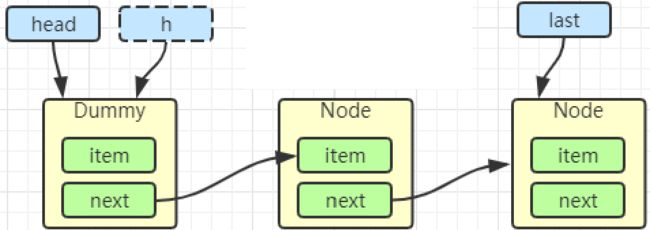
first = h.next
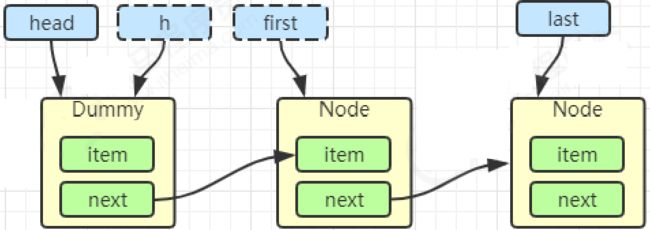
h.next = h

head = first
E x = first.item;
first.item = null;
return x;
2. 加锁分析
高明之处在于用了两把锁和 dummy 节点
- 用一把锁,同一时刻,最多只允许有一个线程(生产者或消费者,二选一)执行
- 用两把锁,同一时刻,可以允许两个线程同时(一个生产者与一个消费者)执行
- 消费者与消费者线程仍然串行
- 生产者与生产者线程仍然串行
线程安全分析
- 当节点总数大于 2 时(包括 dummy 节点),putLock 保证的是 last 节点的线程安全,takeLock 保证的是 head 节点的线程安全。两把锁保证了入队和出队没有竞争
- 当节点总数等于 2 时(即一个 dummy 节点,一个正常节点)这时候,仍然是两把锁锁两个对象,不会竞争
- 当节点总数等于 1 时(就一个 dummy 节点)这时 take 线程会被 notEmpty 条件阻塞,有竞争,会阻塞
// 用于 put(阻塞) offer(非阻塞)
private final ReentrantLock putLock = new ReentrantLock();
// 用户 take(阻塞) poll(非阻塞)
private final ReentrantLock takeLock = new ReentrantLock();
put 操作
public void put(E e) throws InterruptedException {
if (e == null) throw new NullPointerException();
int c = -1;
Node<E> node = new Node<E>(e);
final ReentrantLock putLock = this.putLock;
// count 用来维护元素计数
final AtomicInteger count = this.count;
putLock.lockInterruptibly();
try {
// 满了等待
while (count.get() == capacity) {
// 倒过来读就好: 等待 notFull
notFull.await();
}
// 有空位, 入队且计数加一
enqueue(node);
c = count.getAndIncrement();
// 除了自己 put 以外, 队列还有空位, 由自己叫醒其他 put 线程
if (c + 1 < capacity)
notFull.signal();
} finally {
putLock.unlock();
}
// 如果队列中有一个元素, 叫醒 take 线程
if (c == 0)
// 这里调用的是 notEmpty.signal() 而不是 notEmpty.signalAll() 是为了减少竞争
signalNotEmpty();
}
take 操作
public E take() throws InterruptedException {
E x;
int c = -1;
final AtomicInteger count = this.count;
final ReentrantLock takeLock = this.takeLock;
takeLock.lockInterruptibly();
try {
while (count.get() == 0) {
notEmpty.await();
}
x = dequeue();
c = count.getAndDecrement();
if (c > 1)
notEmpty.signal();
} finally {
takeLock.unlock();
}
// 如果队列中只有一个空位时, 叫醒 put 线程
// 如果有多个线程进行出队, 第一个线程满足 c == capacity, 但后续线程 c < capacity
if (c == capacity)
// 这里调用的是 notFull.signal() 而不是 notFull.signalAll() 是为了减少竞争
signalNotFull()
return x;
}
由 put 唤醒 put 是为了避免信号不足
3. 性能比较
主要列举 LinkedBlockingQueue 与 ArrayBlockingQueue 的性能比较
- Linked 支持有界,Array 强制有界
- Linked 实现是链表,Array 实现是数组
- Linked 是懒惰的,而 Array 需要提前初始化 Node 数组
- Linked 每次入队会生成新 Node,而 Array 的 Node 是提前创建好的
- Linked 两把锁,Array 一把锁
ConcurrentLinkedQueue 原理
1. 模仿 ConcurrentLinkedQueue
初始代码
public class Test3 {
public static void main(String[] args) {
MyQueue<String> queue = new MyQueue<>();
queue.offer("1");
queue.offer("2");
queue.offer("3");
System.out.println(queue);
}
}
class MyQueue<E> implements Queue<E> {
@Override
public String toString() {
StringBuilder sb = new StringBuilder();
for (Node<E> p = head; p != null; p = p.next.get()) {
E item = p.item;
if (item != null) {
sb.append(item).append("->");
}
}
sb.append("null");
return sb.toString();
}
@Override
public int size() {
return 0;
}
@Override
public boolean isEmpty() {
return false;
}
@Override
public boolean contains(Object o) {
return false;
}
@Override
public Iterator<E> iterator() {
return null;
}
@Override
public Object[] toArray() {
return new Object[0];
}
@Override
public <T> T[] toArray(T[] a) {
return null;
}
@Override
public boolean add(E e) {
return false;
}
@Override
public boolean remove(Object o) {
return false;
}
@Override
public boolean containsAll(Collection<?> c) {
return false;
}
@Override
public boolean addAll(Collection<? extends E> c) {
return false;
}
@Override
public boolean removeAll(Collection<?> c) {
return false;
}
@Override
public boolean retainAll(Collection<?> c) {
return false;
}
@Override
public void clear() {
}
@Override
public E remove() {
return null;
}
@Override
public E element() {
return null;
}
@Override
public E peek() {
return null;
}
public MyQueue() {
head = last = new Node<>(null, null);
}
private volatile Node<E> last;
private volatile Node<E> head;
private E dequeue() {
/*Node h = head;
Node first = h.next;
h.next = h;
head = first;
E x = first.item;
first.item = null;
return x;*/
return null;
}
@Override
public E poll() {
return null;
}
@Override
public boolean offer(E e) {
return true;
}
static class Node<E> {
volatile E item;
public Node(E item, Node<E> next) {
this.item = item;
this.next = new AtomicReference<>(next);
}
AtomicReference<Node<E>> next;
}
}
offer
public boolean offer(E e) {
Node<E> n = new Node<>(e, null);
while(true) {
// 获取尾节点
AtomicReference<Node<E>> next = last.next;
// S1: 真正尾节点的 next 是 null, cas 从 null 到新节点
if(next.compareAndSet(null, n)) {
// 这时的 last 已经是倒数第二, next 不为空了, 其它线程的 cas 肯定失败
// S2: 更新 last 为倒数第一的节点
last = n;
return true;
}
}
}


